

Compact Muon Solenoid
LHC, CERN
| CMS-PAS-TOP-17-001 | ||
| Measurement of the $\mathrm{t}\bar{\mathrm{t}}$ production cross section, the top quark mass, and the strong coupling constant using events in the dilepton final state in pp collisions at $\sqrt{s}=$ 13 TeV | ||
| CMS Collaboration | ||
| September 2018 | ||
| Abstract: A measurement of the top quark-antiquark ($\mathrm{t}\bar{\mathrm{t}}$) pair production cross section in proton-proton collisions at a centre-of-mass energy of 13 TeV is presented. The data correspond to an integrated luminosity of 35.9 fb$^{-1}$, recorded by the CMS experiment at the CERN LHC in 2016. Events containing two charged leptons are selected and the cross section is measured from a likelihood fit. For a fixed top quark mass parameter in the simulation of 172.5 GeV the fit yields a measured cross section $\sigma_{\mathrm{t}\bar{\mathrm{t}}}= $ 803 $\pm$ 2 (stat) $\pm$ 25 (syst) $\pm$ 20 (lum) pb, in agreement with the expectation from the standard model calculation at next-to-next-to-leading order (NNLO). A simultaneous fit of the cross section and the top quark mass parameter in the simulation is performed. The resulting cross section is used, together with the NNLO theory prediction, to determine the top quark mass and to extract a value of the strong coupling constant. | ||
|
Links:
CDS record (PDF) ;
CADI line (restricted) ;
These preliminary results are superseded in this paper, EPJC 79 (2019) 368. The superseded preliminary plots can be found here. |
||
| Figures | |

png pdf |
Figure 1:
Transverse momentum (left) and pseudorapidity (right) of leading (upper) and subleading (middle) lepton in the $\mathrm {e^{\mp}}\mu ^{\pm}$ channel after the event selection after the event selection for the data (points) and the predictions for the signal and various background from the simulation (shaded histograms). The lower row shows the jet (left) and b jet (right) multiplicity distributions. The vertical bars on the points represent the statistical uncertainties in the data. The hatched bands correspond to the systematic uncertainty in the ${{\mathrm {t}\overline {\mathrm {t}}}}$ signal MC simulation. The uncertainties in the integrated luminosity and background contributions are not included. The ratios of data to the sum of the predicted yields are shown in the lower panel of each figure. Here, the solid grey band represents the contribution of the statistical uncertainty in the MC simulation. |
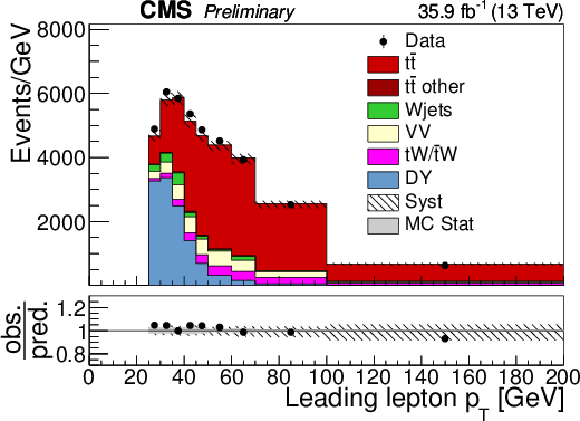
png pdf |
Figure 1-a:
Transverse momentum (left) and pseudorapidity (right) of leading (upper) and subleading (middle) lepton in the $\mathrm {e^{\mp}}\mu ^{\pm}$ channel after the event selection after the event selection for the data (points) and the predictions for the signal and various background from the simulation (shaded histograms). The lower row shows the jet (left) and b jet (right) multiplicity distributions. The vertical bars on the points represent the statistical uncertainties in the data. The hatched bands correspond to the systematic uncertainty in the ${{\mathrm {t}\overline {\mathrm {t}}}}$ signal MC simulation. The uncertainties in the integrated luminosity and background contributions are not included. The ratios of data to the sum of the predicted yields are shown in the lower panel of each figure. Here, the solid grey band represents the contribution of the statistical uncertainty in the MC simulation. |
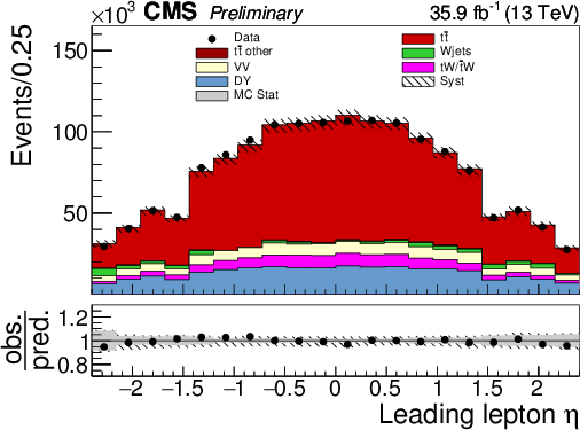
png pdf |
Figure 1-b:
Transverse momentum (left) and pseudorapidity (right) of leading (upper) and subleading (middle) lepton in the $\mathrm {e^{\mp}}\mu ^{\pm}$ channel after the event selection after the event selection for the data (points) and the predictions for the signal and various background from the simulation (shaded histograms). The lower row shows the jet (left) and b jet (right) multiplicity distributions. The vertical bars on the points represent the statistical uncertainties in the data. The hatched bands correspond to the systematic uncertainty in the ${{\mathrm {t}\overline {\mathrm {t}}}}$ signal MC simulation. The uncertainties in the integrated luminosity and background contributions are not included. The ratios of data to the sum of the predicted yields are shown in the lower panel of each figure. Here, the solid grey band represents the contribution of the statistical uncertainty in the MC simulation. |

png pdf |
Figure 1-c:
Transverse momentum (left) and pseudorapidity (right) of leading (upper) and subleading (middle) lepton in the $\mathrm {e^{\mp}}\mu ^{\pm}$ channel after the event selection after the event selection for the data (points) and the predictions for the signal and various background from the simulation (shaded histograms). The lower row shows the jet (left) and b jet (right) multiplicity distributions. The vertical bars on the points represent the statistical uncertainties in the data. The hatched bands correspond to the systematic uncertainty in the ${{\mathrm {t}\overline {\mathrm {t}}}}$ signal MC simulation. The uncertainties in the integrated luminosity and background contributions are not included. The ratios of data to the sum of the predicted yields are shown in the lower panel of each figure. Here, the solid grey band represents the contribution of the statistical uncertainty in the MC simulation. |
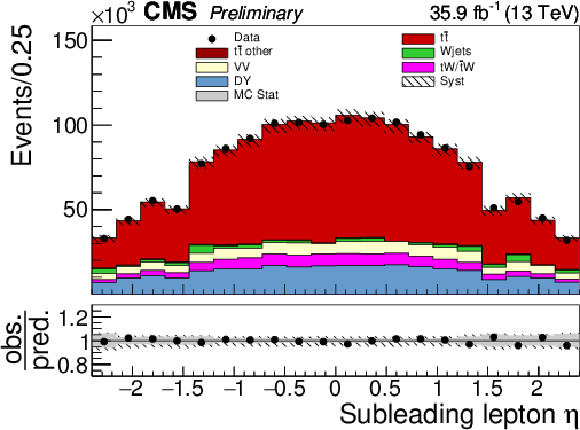
png pdf |
Figure 1-d:
Transverse momentum (left) and pseudorapidity (right) of leading (upper) and subleading (middle) lepton in the $\mathrm {e^{\mp}}\mu ^{\pm}$ channel after the event selection after the event selection for the data (points) and the predictions for the signal and various background from the simulation (shaded histograms). The lower row shows the jet (left) and b jet (right) multiplicity distributions. The vertical bars on the points represent the statistical uncertainties in the data. The hatched bands correspond to the systematic uncertainty in the ${{\mathrm {t}\overline {\mathrm {t}}}}$ signal MC simulation. The uncertainties in the integrated luminosity and background contributions are not included. The ratios of data to the sum of the predicted yields are shown in the lower panel of each figure. Here, the solid grey band represents the contribution of the statistical uncertainty in the MC simulation. |
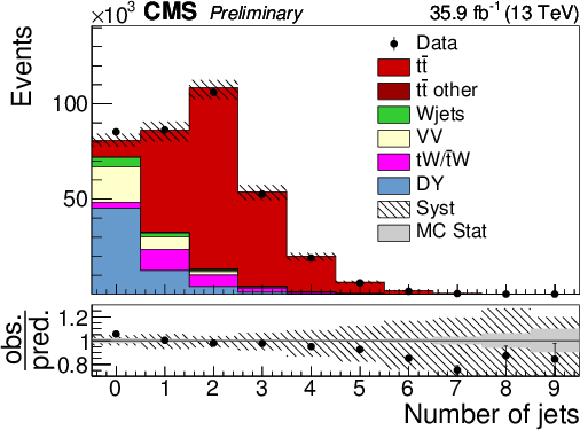
png pdf |
Figure 1-e:
Transverse momentum (left) and pseudorapidity (right) of leading (upper) and subleading (middle) lepton in the $\mathrm {e^{\mp}}\mu ^{\pm}$ channel after the event selection after the event selection for the data (points) and the predictions for the signal and various background from the simulation (shaded histograms). The lower row shows the jet (left) and b jet (right) multiplicity distributions. The vertical bars on the points represent the statistical uncertainties in the data. The hatched bands correspond to the systematic uncertainty in the ${{\mathrm {t}\overline {\mathrm {t}}}}$ signal MC simulation. The uncertainties in the integrated luminosity and background contributions are not included. The ratios of data to the sum of the predicted yields are shown in the lower panel of each figure. Here, the solid grey band represents the contribution of the statistical uncertainty in the MC simulation. |

png pdf |
Figure 1-f:
Transverse momentum (left) and pseudorapidity (right) of leading (upper) and subleading (middle) lepton in the $\mathrm {e^{\mp}}\mu ^{\pm}$ channel after the event selection after the event selection for the data (points) and the predictions for the signal and various background from the simulation (shaded histograms). The lower row shows the jet (left) and b jet (right) multiplicity distributions. The vertical bars on the points represent the statistical uncertainties in the data. The hatched bands correspond to the systematic uncertainty in the ${{\mathrm {t}\overline {\mathrm {t}}}}$ signal MC simulation. The uncertainties in the integrated luminosity and background contributions are not included. The ratios of data to the sum of the predicted yields are shown in the lower panel of each figure. Here, the solid grey band represents the contribution of the statistical uncertainty in the MC simulation. |
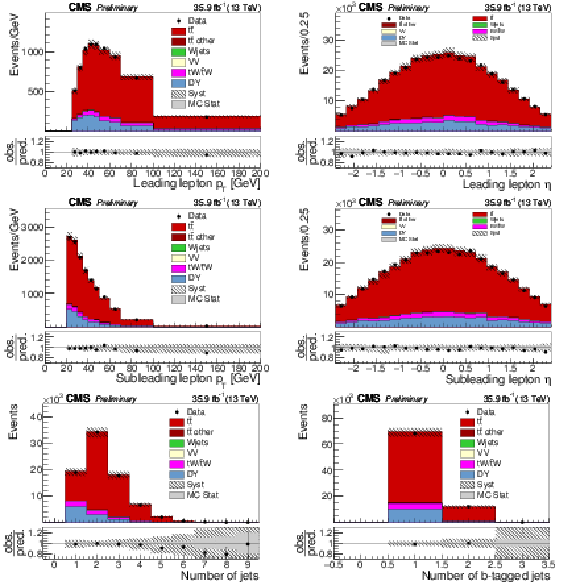
png pdf |
Figure 2:
Transverse momentum (left) and pseudorapidity (right) of leading (upper) and subleading (middle) lepton in the $\mu ^+\mu ^-$ channel after the event selection after the event selection for the data (points) and the predictions for the signal and various background from the simulation (shaded histograms). The lower row shows the jet (left) and b jet (right) multiplicity distributions. The vertical bars on the points represent the statistical uncertainties in the data. The hatched bands correspond to the systematic uncertainty in the ${{\mathrm {t}\overline {\mathrm {t}}}}$ signal MC simulation. The uncertainties in the integrated luminosity and background contributions are not included. The ratios of data to the sum of the predicted yields are shown in the lower panel of each figure. Here, the solid grey band represents the contribution of the statistical uncertainty in the MC simulation. |

png pdf |
Figure 2-a:
Transverse momentum (left) and pseudorapidity (right) of leading (upper) and subleading (middle) lepton in the $\mu ^+\mu ^-$ channel after the event selection after the event selection for the data (points) and the predictions for the signal and various background from the simulation (shaded histograms). The lower row shows the jet (left) and b jet (right) multiplicity distributions. The vertical bars on the points represent the statistical uncertainties in the data. The hatched bands correspond to the systematic uncertainty in the ${{\mathrm {t}\overline {\mathrm {t}}}}$ signal MC simulation. The uncertainties in the integrated luminosity and background contributions are not included. The ratios of data to the sum of the predicted yields are shown in the lower panel of each figure. Here, the solid grey band represents the contribution of the statistical uncertainty in the MC simulation. |
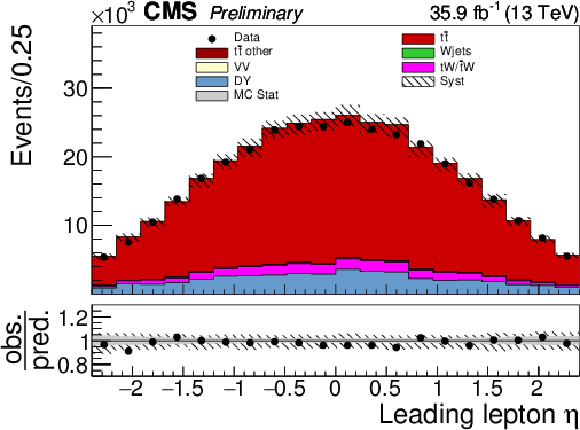
png pdf |
Figure 2-b:
Transverse momentum (left) and pseudorapidity (right) of leading (upper) and subleading (middle) lepton in the $\mu ^+\mu ^-$ channel after the event selection after the event selection for the data (points) and the predictions for the signal and various background from the simulation (shaded histograms). The lower row shows the jet (left) and b jet (right) multiplicity distributions. The vertical bars on the points represent the statistical uncertainties in the data. The hatched bands correspond to the systematic uncertainty in the ${{\mathrm {t}\overline {\mathrm {t}}}}$ signal MC simulation. The uncertainties in the integrated luminosity and background contributions are not included. The ratios of data to the sum of the predicted yields are shown in the lower panel of each figure. Here, the solid grey band represents the contribution of the statistical uncertainty in the MC simulation. |

png pdf |
Figure 2-c:
Transverse momentum (left) and pseudorapidity (right) of leading (upper) and subleading (middle) lepton in the $\mu ^+\mu ^-$ channel after the event selection after the event selection for the data (points) and the predictions for the signal and various background from the simulation (shaded histograms). The lower row shows the jet (left) and b jet (right) multiplicity distributions. The vertical bars on the points represent the statistical uncertainties in the data. The hatched bands correspond to the systematic uncertainty in the ${{\mathrm {t}\overline {\mathrm {t}}}}$ signal MC simulation. The uncertainties in the integrated luminosity and background contributions are not included. The ratios of data to the sum of the predicted yields are shown in the lower panel of each figure. Here, the solid grey band represents the contribution of the statistical uncertainty in the MC simulation. |
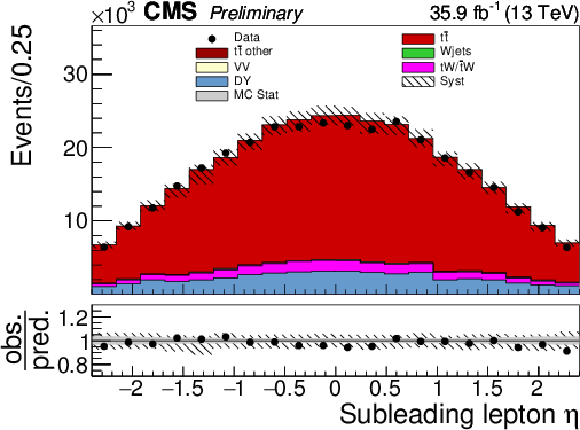
png pdf |
Figure 2-d:
Transverse momentum (left) and pseudorapidity (right) of leading (upper) and subleading (middle) lepton in the $\mu ^+\mu ^-$ channel after the event selection after the event selection for the data (points) and the predictions for the signal and various background from the simulation (shaded histograms). The lower row shows the jet (left) and b jet (right) multiplicity distributions. The vertical bars on the points represent the statistical uncertainties in the data. The hatched bands correspond to the systematic uncertainty in the ${{\mathrm {t}\overline {\mathrm {t}}}}$ signal MC simulation. The uncertainties in the integrated luminosity and background contributions are not included. The ratios of data to the sum of the predicted yields are shown in the lower panel of each figure. Here, the solid grey band represents the contribution of the statistical uncertainty in the MC simulation. |

png pdf |
Figure 2-e:
Transverse momentum (left) and pseudorapidity (right) of leading (upper) and subleading (middle) lepton in the $\mu ^+\mu ^-$ channel after the event selection after the event selection for the data (points) and the predictions for the signal and various background from the simulation (shaded histograms). The lower row shows the jet (left) and b jet (right) multiplicity distributions. The vertical bars on the points represent the statistical uncertainties in the data. The hatched bands correspond to the systematic uncertainty in the ${{\mathrm {t}\overline {\mathrm {t}}}}$ signal MC simulation. The uncertainties in the integrated luminosity and background contributions are not included. The ratios of data to the sum of the predicted yields are shown in the lower panel of each figure. Here, the solid grey band represents the contribution of the statistical uncertainty in the MC simulation. |

png pdf |
Figure 2-f:
Transverse momentum (left) and pseudorapidity (right) of leading (upper) and subleading (middle) lepton in the $\mu ^+\mu ^-$ channel after the event selection after the event selection for the data (points) and the predictions for the signal and various background from the simulation (shaded histograms). The lower row shows the jet (left) and b jet (right) multiplicity distributions. The vertical bars on the points represent the statistical uncertainties in the data. The hatched bands correspond to the systematic uncertainty in the ${{\mathrm {t}\overline {\mathrm {t}}}}$ signal MC simulation. The uncertainties in the integrated luminosity and background contributions are not included. The ratios of data to the sum of the predicted yields are shown in the lower panel of each figure. Here, the solid grey band represents the contribution of the statistical uncertainty in the MC simulation. |

png pdf |
Figure 3:
Transverse momentum (left) and pseudorapidity (right) of leading (upper) and subleading (middle) lepton in the $\mathrm {e^+e^-}$ channel after the event selection after the event selection for the data (points) and the predictions for the signal and various background from the simulation (shaded histograms). The lower row shows the jet (left) and b jet (right) multiplicity distributions. The vertical bars on the points represent the statistical uncertainties in the data. The hatched bands correspond to the systematic uncertainty in the ${{\mathrm {t}\overline {\mathrm {t}}}}$ signal MC simulation. The uncertainties in the integrated luminosity and background contributions are not included. The ratios of data to the sum of the predicted yields are shown in the lower panel of each figure. Here, the solid grey band represents the contribution of the statistical uncertainty in the MC simulation. |

png pdf |
Figure 3-a:
Transverse momentum (left) and pseudorapidity (right) of leading (upper) and subleading (middle) lepton in the $\mathrm {e^+e^-}$ channel after the event selection after the event selection for the data (points) and the predictions for the signal and various background from the simulation (shaded histograms). The lower row shows the jet (left) and b jet (right) multiplicity distributions. The vertical bars on the points represent the statistical uncertainties in the data. The hatched bands correspond to the systematic uncertainty in the ${{\mathrm {t}\overline {\mathrm {t}}}}$ signal MC simulation. The uncertainties in the integrated luminosity and background contributions are not included. The ratios of data to the sum of the predicted yields are shown in the lower panel of each figure. Here, the solid grey band represents the contribution of the statistical uncertainty in the MC simulation. |
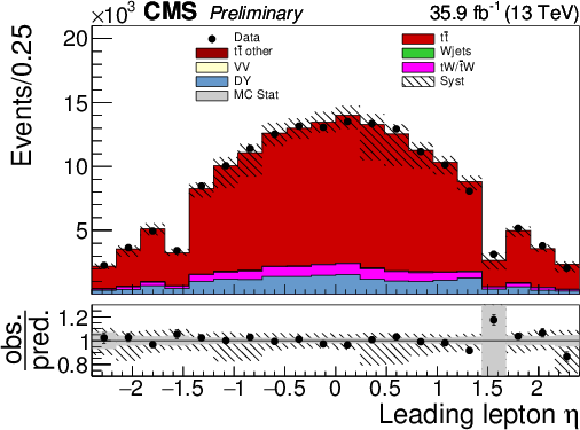
png pdf |
Figure 3-b:
Transverse momentum (left) and pseudorapidity (right) of leading (upper) and subleading (middle) lepton in the $\mathrm {e^+e^-}$ channel after the event selection after the event selection for the data (points) and the predictions for the signal and various background from the simulation (shaded histograms). The lower row shows the jet (left) and b jet (right) multiplicity distributions. The vertical bars on the points represent the statistical uncertainties in the data. The hatched bands correspond to the systematic uncertainty in the ${{\mathrm {t}\overline {\mathrm {t}}}}$ signal MC simulation. The uncertainties in the integrated luminosity and background contributions are not included. The ratios of data to the sum of the predicted yields are shown in the lower panel of each figure. Here, the solid grey band represents the contribution of the statistical uncertainty in the MC simulation. |

png pdf |
Figure 3-c:
Transverse momentum (left) and pseudorapidity (right) of leading (upper) and subleading (middle) lepton in the $\mathrm {e^+e^-}$ channel after the event selection after the event selection for the data (points) and the predictions for the signal and various background from the simulation (shaded histograms). The lower row shows the jet (left) and b jet (right) multiplicity distributions. The vertical bars on the points represent the statistical uncertainties in the data. The hatched bands correspond to the systematic uncertainty in the ${{\mathrm {t}\overline {\mathrm {t}}}}$ signal MC simulation. The uncertainties in the integrated luminosity and background contributions are not included. The ratios of data to the sum of the predicted yields are shown in the lower panel of each figure. Here, the solid grey band represents the contribution of the statistical uncertainty in the MC simulation. |
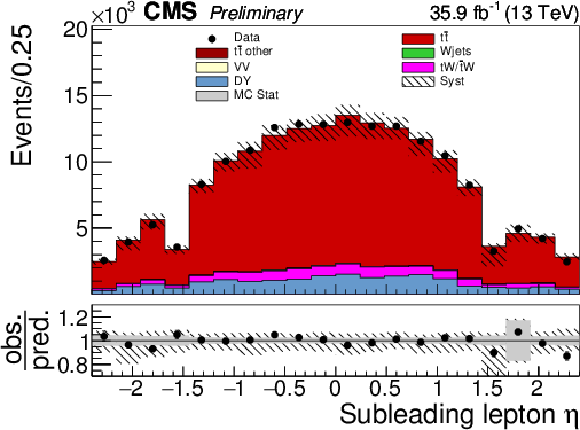
png pdf |
Figure 3-d:
Transverse momentum (left) and pseudorapidity (right) of leading (upper) and subleading (middle) lepton in the $\mathrm {e^+e^-}$ channel after the event selection after the event selection for the data (points) and the predictions for the signal and various background from the simulation (shaded histograms). The lower row shows the jet (left) and b jet (right) multiplicity distributions. The vertical bars on the points represent the statistical uncertainties in the data. The hatched bands correspond to the systematic uncertainty in the ${{\mathrm {t}\overline {\mathrm {t}}}}$ signal MC simulation. The uncertainties in the integrated luminosity and background contributions are not included. The ratios of data to the sum of the predicted yields are shown in the lower panel of each figure. Here, the solid grey band represents the contribution of the statistical uncertainty in the MC simulation. |

png pdf |
Figure 3-e:
Transverse momentum (left) and pseudorapidity (right) of leading (upper) and subleading (middle) lepton in the $\mathrm {e^+e^-}$ channel after the event selection after the event selection for the data (points) and the predictions for the signal and various background from the simulation (shaded histograms). The lower row shows the jet (left) and b jet (right) multiplicity distributions. The vertical bars on the points represent the statistical uncertainties in the data. The hatched bands correspond to the systematic uncertainty in the ${{\mathrm {t}\overline {\mathrm {t}}}}$ signal MC simulation. The uncertainties in the integrated luminosity and background contributions are not included. The ratios of data to the sum of the predicted yields are shown in the lower panel of each figure. Here, the solid grey band represents the contribution of the statistical uncertainty in the MC simulation. |

png pdf |
Figure 3-f:
Transverse momentum (left) and pseudorapidity (right) of leading (upper) and subleading (middle) lepton in the $\mathrm {e^+e^-}$ channel after the event selection after the event selection for the data (points) and the predictions for the signal and various background from the simulation (shaded histograms). The lower row shows the jet (left) and b jet (right) multiplicity distributions. The vertical bars on the points represent the statistical uncertainties in the data. The hatched bands correspond to the systematic uncertainty in the ${{\mathrm {t}\overline {\mathrm {t}}}}$ signal MC simulation. The uncertainties in the integrated luminosity and background contributions are not included. The ratios of data to the sum of the predicted yields are shown in the lower panel of each figure. Here, the solid grey band represents the contribution of the statistical uncertainty in the MC simulation. |

png pdf |
Figure 4:
Kinematic distributions in the $\mathrm {e^{\mp}}\mu ^{\pm}$ channel after the fit of the simulation to the data. In the left column events with zero or three or more b-tagged jets are shown. The middle (right) columns show events with exactly one (two) b-tagged jets. Events with zero, one, two, or three additional non-b-tagged jets are shown in the first, second, third and fourth row, respectively. For events with at least one additional non-b-tagged jet, the transverse momentum distributions of the jet with the smallest transverse momentum in the respective category is considered. The hatched bands correspond to the total uncertainty in the sum of the predicted yields including all correlations. The ratios of the data to the sum of the simulated yields after the fit are shown in the lower panel of each figure. Here, the solid grey band represents the contribution of the statistical uncertainty in the MC simulation. |

png pdf |
Figure 4-a:
Kinematic distributions in the $\mathrm {e^{\mp}}\mu ^{\pm}$ channel after the fit of the simulation to the data. In the left column events with zero or three or more b-tagged jets are shown. The middle (right) columns show events with exactly one (two) b-tagged jets. Events with zero, one, two, or three additional non-b-tagged jets are shown in the first, second, third and fourth row, respectively. For events with at least one additional non-b-tagged jet, the transverse momentum distributions of the jet with the smallest transverse momentum in the respective category is considered. The hatched bands correspond to the total uncertainty in the sum of the predicted yields including all correlations. The ratios of the data to the sum of the simulated yields after the fit are shown in the lower panel of each figure. Here, the solid grey band represents the contribution of the statistical uncertainty in the MC simulation. |
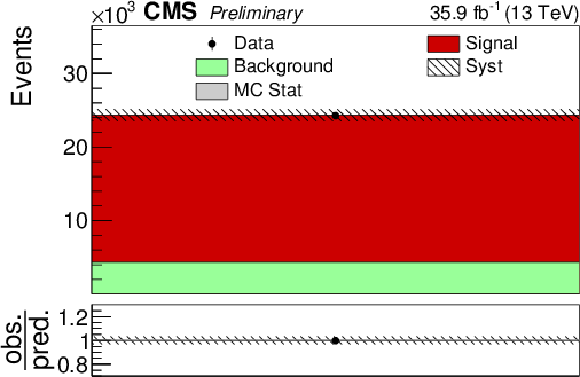
png pdf |
Figure 4-b:
Kinematic distributions in the $\mathrm {e^{\mp}}\mu ^{\pm}$ channel after the fit of the simulation to the data. In the left column events with zero or three or more b-tagged jets are shown. The middle (right) columns show events with exactly one (two) b-tagged jets. Events with zero, one, two, or three additional non-b-tagged jets are shown in the first, second, third and fourth row, respectively. For events with at least one additional non-b-tagged jet, the transverse momentum distributions of the jet with the smallest transverse momentum in the respective category is considered. The hatched bands correspond to the total uncertainty in the sum of the predicted yields including all correlations. The ratios of the data to the sum of the simulated yields after the fit are shown in the lower panel of each figure. Here, the solid grey band represents the contribution of the statistical uncertainty in the MC simulation. |

png pdf |
Figure 4-c:
Kinematic distributions in the $\mathrm {e^{\mp}}\mu ^{\pm}$ channel after the fit of the simulation to the data. In the left column events with zero or three or more b-tagged jets are shown. The middle (right) columns show events with exactly one (two) b-tagged jets. Events with zero, one, two, or three additional non-b-tagged jets are shown in the first, second, third and fourth row, respectively. For events with at least one additional non-b-tagged jet, the transverse momentum distributions of the jet with the smallest transverse momentum in the respective category is considered. The hatched bands correspond to the total uncertainty in the sum of the predicted yields including all correlations. The ratios of the data to the sum of the simulated yields after the fit are shown in the lower panel of each figure. Here, the solid grey band represents the contribution of the statistical uncertainty in the MC simulation. |

png pdf |
Figure 4-d:
Kinematic distributions in the $\mathrm {e^{\mp}}\mu ^{\pm}$ channel after the fit of the simulation to the data. In the left column events with zero or three or more b-tagged jets are shown. The middle (right) columns show events with exactly one (two) b-tagged jets. Events with zero, one, two, or three additional non-b-tagged jets are shown in the first, second, third and fourth row, respectively. For events with at least one additional non-b-tagged jet, the transverse momentum distributions of the jet with the smallest transverse momentum in the respective category is considered. The hatched bands correspond to the total uncertainty in the sum of the predicted yields including all correlations. The ratios of the data to the sum of the simulated yields after the fit are shown in the lower panel of each figure. Here, the solid grey band represents the contribution of the statistical uncertainty in the MC simulation. |

png pdf |
Figure 4-e:
Kinematic distributions in the $\mathrm {e^{\mp}}\mu ^{\pm}$ channel after the fit of the simulation to the data. In the left column events with zero or three or more b-tagged jets are shown. The middle (right) columns show events with exactly one (two) b-tagged jets. Events with zero, one, two, or three additional non-b-tagged jets are shown in the first, second, third and fourth row, respectively. For events with at least one additional non-b-tagged jet, the transverse momentum distributions of the jet with the smallest transverse momentum in the respective category is considered. The hatched bands correspond to the total uncertainty in the sum of the predicted yields including all correlations. The ratios of the data to the sum of the simulated yields after the fit are shown in the lower panel of each figure. Here, the solid grey band represents the contribution of the statistical uncertainty in the MC simulation. |

png pdf |
Figure 4-f:
Kinematic distributions in the $\mathrm {e^{\mp}}\mu ^{\pm}$ channel after the fit of the simulation to the data. In the left column events with zero or three or more b-tagged jets are shown. The middle (right) columns show events with exactly one (two) b-tagged jets. Events with zero, one, two, or three additional non-b-tagged jets are shown in the first, second, third and fourth row, respectively. For events with at least one additional non-b-tagged jet, the transverse momentum distributions of the jet with the smallest transverse momentum in the respective category is considered. The hatched bands correspond to the total uncertainty in the sum of the predicted yields including all correlations. The ratios of the data to the sum of the simulated yields after the fit are shown in the lower panel of each figure. Here, the solid grey band represents the contribution of the statistical uncertainty in the MC simulation. |
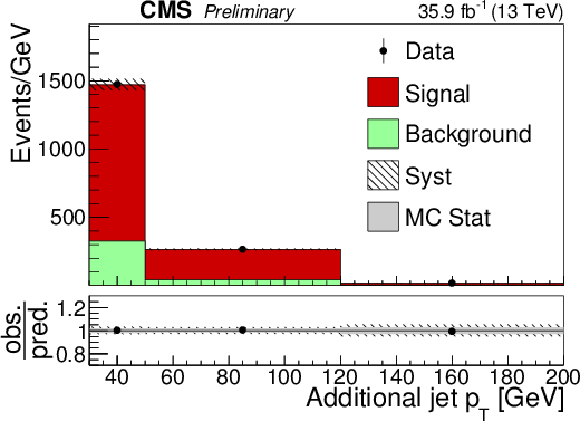
png pdf |
Figure 4-g:
Kinematic distributions in the $\mathrm {e^{\mp}}\mu ^{\pm}$ channel after the fit of the simulation to the data. In the left column events with zero or three or more b-tagged jets are shown. The middle (right) columns show events with exactly one (two) b-tagged jets. Events with zero, one, two, or three additional non-b-tagged jets are shown in the first, second, third and fourth row, respectively. For events with at least one additional non-b-tagged jet, the transverse momentum distributions of the jet with the smallest transverse momentum in the respective category is considered. The hatched bands correspond to the total uncertainty in the sum of the predicted yields including all correlations. The ratios of the data to the sum of the simulated yields after the fit are shown in the lower panel of each figure. Here, the solid grey band represents the contribution of the statistical uncertainty in the MC simulation. |
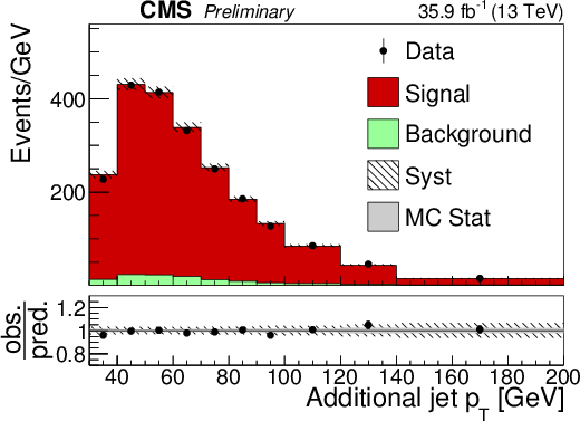
png pdf |
Figure 4-h:
Kinematic distributions in the $\mathrm {e^{\mp}}\mu ^{\pm}$ channel after the fit of the simulation to the data. In the left column events with zero or three or more b-tagged jets are shown. The middle (right) columns show events with exactly one (two) b-tagged jets. Events with zero, one, two, or three additional non-b-tagged jets are shown in the first, second, third and fourth row, respectively. For events with at least one additional non-b-tagged jet, the transverse momentum distributions of the jet with the smallest transverse momentum in the respective category is considered. The hatched bands correspond to the total uncertainty in the sum of the predicted yields including all correlations. The ratios of the data to the sum of the simulated yields after the fit are shown in the lower panel of each figure. Here, the solid grey band represents the contribution of the statistical uncertainty in the MC simulation. |

png pdf |
Figure 4-i:
Kinematic distributions in the $\mathrm {e^{\mp}}\mu ^{\pm}$ channel after the fit of the simulation to the data. In the left column events with zero or three or more b-tagged jets are shown. The middle (right) columns show events with exactly one (two) b-tagged jets. Events with zero, one, two, or three additional non-b-tagged jets are shown in the first, second, third and fourth row, respectively. For events with at least one additional non-b-tagged jet, the transverse momentum distributions of the jet with the smallest transverse momentum in the respective category is considered. The hatched bands correspond to the total uncertainty in the sum of the predicted yields including all correlations. The ratios of the data to the sum of the simulated yields after the fit are shown in the lower panel of each figure. Here, the solid grey band represents the contribution of the statistical uncertainty in the MC simulation. |

png pdf |
Figure 4-j:
Kinematic distributions in the $\mathrm {e^{\mp}}\mu ^{\pm}$ channel after the fit of the simulation to the data. In the left column events with zero or three or more b-tagged jets are shown. The middle (right) columns show events with exactly one (two) b-tagged jets. Events with zero, one, two, or three additional non-b-tagged jets are shown in the first, second, third and fourth row, respectively. For events with at least one additional non-b-tagged jet, the transverse momentum distributions of the jet with the smallest transverse momentum in the respective category is considered. The hatched bands correspond to the total uncertainty in the sum of the predicted yields including all correlations. The ratios of the data to the sum of the simulated yields after the fit are shown in the lower panel of each figure. Here, the solid grey band represents the contribution of the statistical uncertainty in the MC simulation. |

png pdf |
Figure 4-k:
Kinematic distributions in the $\mathrm {e^{\mp}}\mu ^{\pm}$ channel after the fit of the simulation to the data. In the left column events with zero or three or more b-tagged jets are shown. The middle (right) columns show events with exactly one (two) b-tagged jets. Events with zero, one, two, or three additional non-b-tagged jets are shown in the first, second, third and fourth row, respectively. For events with at least one additional non-b-tagged jet, the transverse momentum distributions of the jet with the smallest transverse momentum in the respective category is considered. The hatched bands correspond to the total uncertainty in the sum of the predicted yields including all correlations. The ratios of the data to the sum of the simulated yields after the fit are shown in the lower panel of each figure. Here, the solid grey band represents the contribution of the statistical uncertainty in the MC simulation. |

png pdf |
Figure 4-l:
Kinematic distributions in the $\mathrm {e^{\mp}}\mu ^{\pm}$ channel after the fit of the simulation to the data. In the left column events with zero or three or more b-tagged jets are shown. The middle (right) columns show events with exactly one (two) b-tagged jets. Events with zero, one, two, or three additional non-b-tagged jets are shown in the first, second, third and fourth row, respectively. For events with at least one additional non-b-tagged jet, the transverse momentum distributions of the jet with the smallest transverse momentum in the respective category is considered. The hatched bands correspond to the total uncertainty in the sum of the predicted yields including all correlations. The ratios of the data to the sum of the simulated yields after the fit are shown in the lower panel of each figure. Here, the solid grey band represents the contribution of the statistical uncertainty in the MC simulation. |

png pdf |
Figure 5:
Kinematic distributions in the $\mu ^+\mu ^-$ channel after the fit of the simulation to the data. The left (right) columns show events with exactly one (two) b-tagged jets. Events with zero, one, two, or three additional non-b-tagged jets are shown in the first, second, third and fourth row, respectively. For events with at least one additional non-b-tagged jet, the transverse momentum distributions of the jet with the smallest transverse momentum in the respective category is considered. The hatched bands correspond to the total uncertainty in the sum of the predicted yields including all correlations. The ratios of the data to the sum of the simulated yields after the fit are shown in the lower panel of each figure. Here, the solid grey band represents the contribution of the statistical uncertainty in the MC simulation. |

png pdf |
Figure 5-a:
Kinematic distributions in the $\mu ^+\mu ^-$ channel after the fit of the simulation to the data. The left (right) columns show events with exactly one (two) b-tagged jets. Events with zero, one, two, or three additional non-b-tagged jets are shown in the first, second, third and fourth row, respectively. For events with at least one additional non-b-tagged jet, the transverse momentum distributions of the jet with the smallest transverse momentum in the respective category is considered. The hatched bands correspond to the total uncertainty in the sum of the predicted yields including all correlations. The ratios of the data to the sum of the simulated yields after the fit are shown in the lower panel of each figure. Here, the solid grey band represents the contribution of the statistical uncertainty in the MC simulation. |
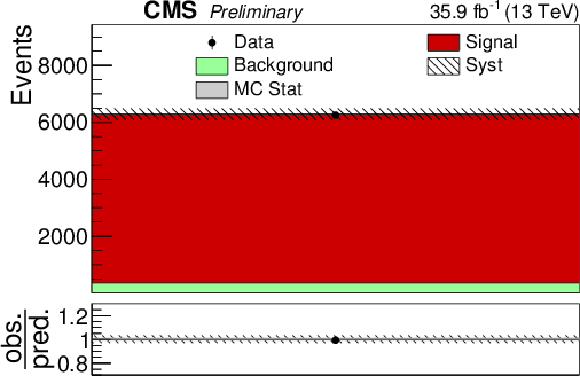
png pdf |
Figure 5-b:
Kinematic distributions in the $\mu ^+\mu ^-$ channel after the fit of the simulation to the data. The left (right) columns show events with exactly one (two) b-tagged jets. Events with zero, one, two, or three additional non-b-tagged jets are shown in the first, second, third and fourth row, respectively. For events with at least one additional non-b-tagged jet, the transverse momentum distributions of the jet with the smallest transverse momentum in the respective category is considered. The hatched bands correspond to the total uncertainty in the sum of the predicted yields including all correlations. The ratios of the data to the sum of the simulated yields after the fit are shown in the lower panel of each figure. Here, the solid grey band represents the contribution of the statistical uncertainty in the MC simulation. |
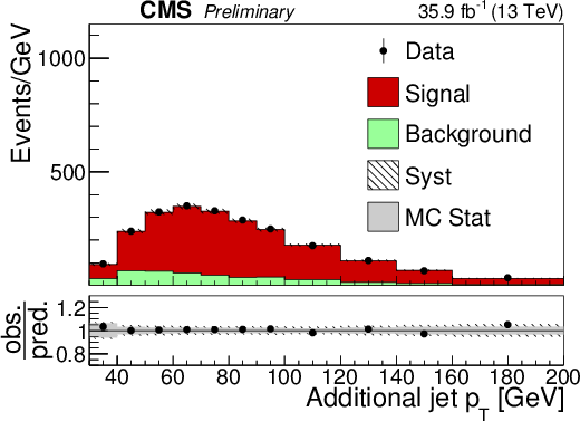
png pdf |
Figure 5-c:
Kinematic distributions in the $\mu ^+\mu ^-$ channel after the fit of the simulation to the data. The left (right) columns show events with exactly one (two) b-tagged jets. Events with zero, one, two, or three additional non-b-tagged jets are shown in the first, second, third and fourth row, respectively. For events with at least one additional non-b-tagged jet, the transverse momentum distributions of the jet with the smallest transverse momentum in the respective category is considered. The hatched bands correspond to the total uncertainty in the sum of the predicted yields including all correlations. The ratios of the data to the sum of the simulated yields after the fit are shown in the lower panel of each figure. Here, the solid grey band represents the contribution of the statistical uncertainty in the MC simulation. |

png pdf |
Figure 5-d:
Kinematic distributions in the $\mu ^+\mu ^-$ channel after the fit of the simulation to the data. The left (right) columns show events with exactly one (two) b-tagged jets. Events with zero, one, two, or three additional non-b-tagged jets are shown in the first, second, third and fourth row, respectively. For events with at least one additional non-b-tagged jet, the transverse momentum distributions of the jet with the smallest transverse momentum in the respective category is considered. The hatched bands correspond to the total uncertainty in the sum of the predicted yields including all correlations. The ratios of the data to the sum of the simulated yields after the fit are shown in the lower panel of each figure. Here, the solid grey band represents the contribution of the statistical uncertainty in the MC simulation. |

png pdf |
Figure 5-e:
Kinematic distributions in the $\mu ^+\mu ^-$ channel after the fit of the simulation to the data. The left (right) columns show events with exactly one (two) b-tagged jets. Events with zero, one, two, or three additional non-b-tagged jets are shown in the first, second, third and fourth row, respectively. For events with at least one additional non-b-tagged jet, the transverse momentum distributions of the jet with the smallest transverse momentum in the respective category is considered. The hatched bands correspond to the total uncertainty in the sum of the predicted yields including all correlations. The ratios of the data to the sum of the simulated yields after the fit are shown in the lower panel of each figure. Here, the solid grey band represents the contribution of the statistical uncertainty in the MC simulation. |

png pdf |
Figure 5-f:
Kinematic distributions in the $\mu ^+\mu ^-$ channel after the fit of the simulation to the data. The left (right) columns show events with exactly one (two) b-tagged jets. Events with zero, one, two, or three additional non-b-tagged jets are shown in the first, second, third and fourth row, respectively. For events with at least one additional non-b-tagged jet, the transverse momentum distributions of the jet with the smallest transverse momentum in the respective category is considered. The hatched bands correspond to the total uncertainty in the sum of the predicted yields including all correlations. The ratios of the data to the sum of the simulated yields after the fit are shown in the lower panel of each figure. Here, the solid grey band represents the contribution of the statistical uncertainty in the MC simulation. |
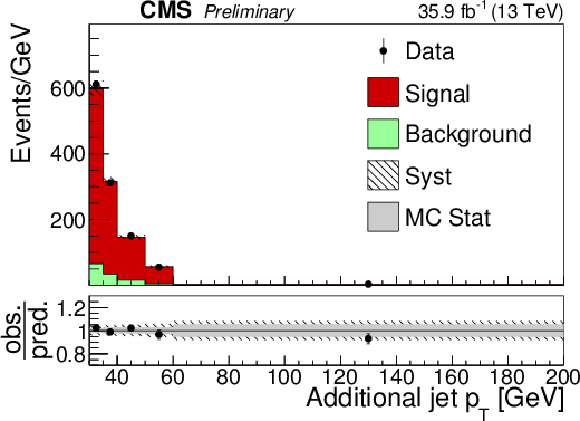
png pdf |
Figure 5-g:
Kinematic distributions in the $\mu ^+\mu ^-$ channel after the fit of the simulation to the data. The left (right) columns show events with exactly one (two) b-tagged jets. Events with zero, one, two, or three additional non-b-tagged jets are shown in the first, second, third and fourth row, respectively. For events with at least one additional non-b-tagged jet, the transverse momentum distributions of the jet with the smallest transverse momentum in the respective category is considered. The hatched bands correspond to the total uncertainty in the sum of the predicted yields including all correlations. The ratios of the data to the sum of the simulated yields after the fit are shown in the lower panel of each figure. Here, the solid grey band represents the contribution of the statistical uncertainty in the MC simulation. |

png pdf |
Figure 5-h:
Kinematic distributions in the $\mu ^+\mu ^-$ channel after the fit of the simulation to the data. The left (right) columns show events with exactly one (two) b-tagged jets. Events with zero, one, two, or three additional non-b-tagged jets are shown in the first, second, third and fourth row, respectively. For events with at least one additional non-b-tagged jet, the transverse momentum distributions of the jet with the smallest transverse momentum in the respective category is considered. The hatched bands correspond to the total uncertainty in the sum of the predicted yields including all correlations. The ratios of the data to the sum of the simulated yields after the fit are shown in the lower panel of each figure. Here, the solid grey band represents the contribution of the statistical uncertainty in the MC simulation. |

png pdf |
Figure 6:
Kinematic distributions in the $\mathrm {e^+e^-}$ channel after the fit of the simulation to the data. The left (right) columns show events with exactly one (two) b-tagged jets. Events with zero, one, two, or three additional non-b-tagged jets are shown in the first, second, third, and fourth row, respectively. For events with at least one additional non-b-tagged jet, the transverse momentum distributions of the jet with the smallest transverse momentum in the respective category is considered. The hatched bands correspond to the total uncertainty in the sum of the predicted yields including all correlations. The ratios of the data to the sum of the simulated yields after the fit are shown in the lower panel of each figure. Here, the solid grey band represents the contribution of the statistical uncertainty in the MC simulation. |

png pdf |
Figure 6-a:
Kinematic distributions in the $\mathrm {e^+e^-}$ channel after the fit of the simulation to the data. The left (right) columns show events with exactly one (two) b-tagged jets. Events with zero, one, two, or three additional non-b-tagged jets are shown in the first, second, third, and fourth row, respectively. For events with at least one additional non-b-tagged jet, the transverse momentum distributions of the jet with the smallest transverse momentum in the respective category is considered. The hatched bands correspond to the total uncertainty in the sum of the predicted yields including all correlations. The ratios of the data to the sum of the simulated yields after the fit are shown in the lower panel of each figure. Here, the solid grey band represents the contribution of the statistical uncertainty in the MC simulation. |
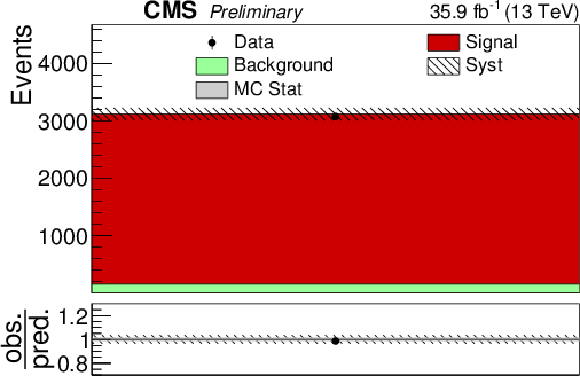
png pdf |
Figure 6-b:
Kinematic distributions in the $\mathrm {e^+e^-}$ channel after the fit of the simulation to the data. The left (right) columns show events with exactly one (two) b-tagged jets. Events with zero, one, two, or three additional non-b-tagged jets are shown in the first, second, third, and fourth row, respectively. For events with at least one additional non-b-tagged jet, the transverse momentum distributions of the jet with the smallest transverse momentum in the respective category is considered. The hatched bands correspond to the total uncertainty in the sum of the predicted yields including all correlations. The ratios of the data to the sum of the simulated yields after the fit are shown in the lower panel of each figure. Here, the solid grey band represents the contribution of the statistical uncertainty in the MC simulation. |
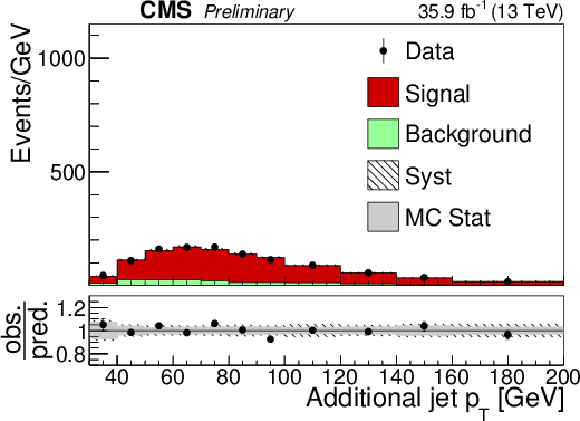
png pdf |
Figure 6-c:
Kinematic distributions in the $\mathrm {e^+e^-}$ channel after the fit of the simulation to the data. The left (right) columns show events with exactly one (two) b-tagged jets. Events with zero, one, two, or three additional non-b-tagged jets are shown in the first, second, third, and fourth row, respectively. For events with at least one additional non-b-tagged jet, the transverse momentum distributions of the jet with the smallest transverse momentum in the respective category is considered. The hatched bands correspond to the total uncertainty in the sum of the predicted yields including all correlations. The ratios of the data to the sum of the simulated yields after the fit are shown in the lower panel of each figure. Here, the solid grey band represents the contribution of the statistical uncertainty in the MC simulation. |
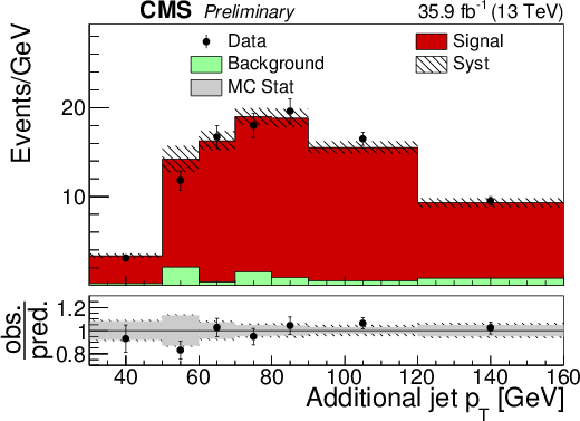
png pdf |
Figure 6-d:
Kinematic distributions in the $\mathrm {e^+e^-}$ channel after the fit of the simulation to the data. The left (right) columns show events with exactly one (two) b-tagged jets. Events with zero, one, two, or three additional non-b-tagged jets are shown in the first, second, third, and fourth row, respectively. For events with at least one additional non-b-tagged jet, the transverse momentum distributions of the jet with the smallest transverse momentum in the respective category is considered. The hatched bands correspond to the total uncertainty in the sum of the predicted yields including all correlations. The ratios of the data to the sum of the simulated yields after the fit are shown in the lower panel of each figure. Here, the solid grey band represents the contribution of the statistical uncertainty in the MC simulation. |
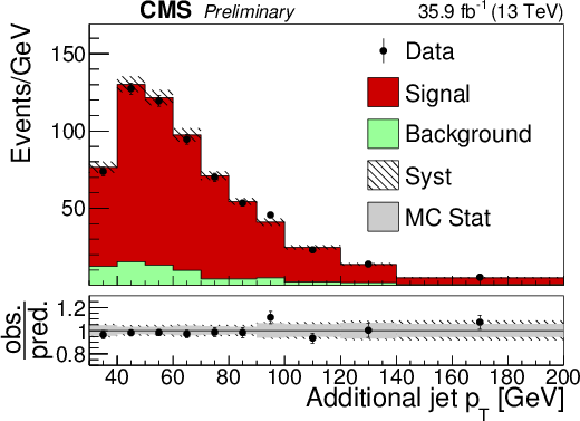
png pdf |
Figure 6-e:
Kinematic distributions in the $\mathrm {e^+e^-}$ channel after the fit of the simulation to the data. The left (right) columns show events with exactly one (two) b-tagged jets. Events with zero, one, two, or three additional non-b-tagged jets are shown in the first, second, third, and fourth row, respectively. For events with at least one additional non-b-tagged jet, the transverse momentum distributions of the jet with the smallest transverse momentum in the respective category is considered. The hatched bands correspond to the total uncertainty in the sum of the predicted yields including all correlations. The ratios of the data to the sum of the simulated yields after the fit are shown in the lower panel of each figure. Here, the solid grey band represents the contribution of the statistical uncertainty in the MC simulation. |

png pdf |
Figure 6-f:
Kinematic distributions in the $\mathrm {e^+e^-}$ channel after the fit of the simulation to the data. The left (right) columns show events with exactly one (two) b-tagged jets. Events with zero, one, two, or three additional non-b-tagged jets are shown in the first, second, third, and fourth row, respectively. For events with at least one additional non-b-tagged jet, the transverse momentum distributions of the jet with the smallest transverse momentum in the respective category is considered. The hatched bands correspond to the total uncertainty in the sum of the predicted yields including all correlations. The ratios of the data to the sum of the simulated yields after the fit are shown in the lower panel of each figure. Here, the solid grey band represents the contribution of the statistical uncertainty in the MC simulation. |

png pdf |
Figure 6-g:
Kinematic distributions in the $\mathrm {e^+e^-}$ channel after the fit of the simulation to the data. The left (right) columns show events with exactly one (two) b-tagged jets. Events with zero, one, two, or three additional non-b-tagged jets are shown in the first, second, third, and fourth row, respectively. For events with at least one additional non-b-tagged jet, the transverse momentum distributions of the jet with the smallest transverse momentum in the respective category is considered. The hatched bands correspond to the total uncertainty in the sum of the predicted yields including all correlations. The ratios of the data to the sum of the simulated yields after the fit are shown in the lower panel of each figure. Here, the solid grey band represents the contribution of the statistical uncertainty in the MC simulation. |

png pdf |
Figure 6-h:
Kinematic distributions in the $\mathrm {e^+e^-}$ channel after the fit of the simulation to the data. The left (right) columns show events with exactly one (two) b-tagged jets. Events with zero, one, two, or three additional non-b-tagged jets are shown in the first, second, third, and fourth row, respectively. For events with at least one additional non-b-tagged jet, the transverse momentum distributions of the jet with the smallest transverse momentum in the respective category is considered. The hatched bands correspond to the total uncertainty in the sum of the predicted yields including all correlations. The ratios of the data to the sum of the simulated yields after the fit are shown in the lower panel of each figure. Here, the solid grey band represents the contribution of the statistical uncertainty in the MC simulation. |

png pdf |
Figure 7:
Pulls and constraints of the nuisance parameters related to modelling uncertainties for the cross section fit. The marker denotes the fitted value, while the inner error band represents the constraint and the outer error band denotes the additional uncertainty from the toy experiments. The horizontal bars represent the pre-fit uncertainty. |

png pdf |
Figure 8:
Pre-fit distributions for the simultaneous fit of ${\sigma _{\mathrm {t}\overline {\mathrm {t}}}}$ and ${m_\mathrm {t}^{\mathrm {MC}}}$. Categories in the same column have the same number of b-tagged jets (from left to right: zero or more than two, one, and two b-tagged jets) while categories in the same row have the same number of additional jets (uppermost to lowermost: zero additional jets, one additional jet, two additional jets, three or more additional jets). The hatched bands correspond to the total uncertainty in the sum of the predicted yields. The ratios of data to the sum of the predicted yields are shown in the lower panel of each figure. Here, the solid grey band represents the contribution of the statistical uncertainty. |

png pdf |
Figure 8-a:
Pre-fit distributions for the simultaneous fit of ${\sigma _{\mathrm {t}\overline {\mathrm {t}}}}$ and ${m_\mathrm {t}^{\mathrm {MC}}}$. Categories in the same column have the same number of b-tagged jets (from left to right: zero or more than two, one, and two b-tagged jets) while categories in the same row have the same number of additional jets (uppermost to lowermost: zero additional jets, one additional jet, two additional jets, three or more additional jets). The hatched bands correspond to the total uncertainty in the sum of the predicted yields. The ratios of data to the sum of the predicted yields are shown in the lower panel of each figure. Here, the solid grey band represents the contribution of the statistical uncertainty. |

png pdf |
Figure 8-b:
Pre-fit distributions for the simultaneous fit of ${\sigma _{\mathrm {t}\overline {\mathrm {t}}}}$ and ${m_\mathrm {t}^{\mathrm {MC}}}$. Categories in the same column have the same number of b-tagged jets (from left to right: zero or more than two, one, and two b-tagged jets) while categories in the same row have the same number of additional jets (uppermost to lowermost: zero additional jets, one additional jet, two additional jets, three or more additional jets). The hatched bands correspond to the total uncertainty in the sum of the predicted yields. The ratios of data to the sum of the predicted yields are shown in the lower panel of each figure. Here, the solid grey band represents the contribution of the statistical uncertainty. |
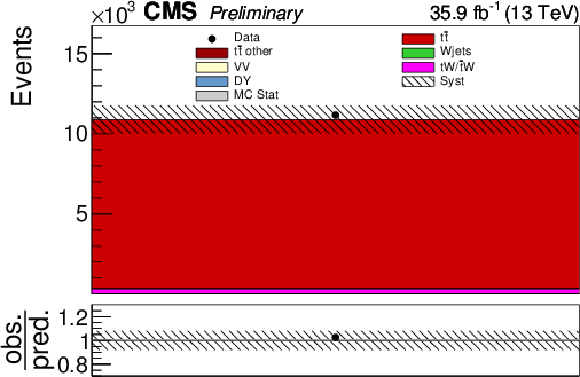
png pdf |
Figure 8-c:
Pre-fit distributions for the simultaneous fit of ${\sigma _{\mathrm {t}\overline {\mathrm {t}}}}$ and ${m_\mathrm {t}^{\mathrm {MC}}}$. Categories in the same column have the same number of b-tagged jets (from left to right: zero or more than two, one, and two b-tagged jets) while categories in the same row have the same number of additional jets (uppermost to lowermost: zero additional jets, one additional jet, two additional jets, three or more additional jets). The hatched bands correspond to the total uncertainty in the sum of the predicted yields. The ratios of data to the sum of the predicted yields are shown in the lower panel of each figure. Here, the solid grey band represents the contribution of the statistical uncertainty. |

png pdf |
Figure 8-d:
Pre-fit distributions for the simultaneous fit of ${\sigma _{\mathrm {t}\overline {\mathrm {t}}}}$ and ${m_\mathrm {t}^{\mathrm {MC}}}$. Categories in the same column have the same number of b-tagged jets (from left to right: zero or more than two, one, and two b-tagged jets) while categories in the same row have the same number of additional jets (uppermost to lowermost: zero additional jets, one additional jet, two additional jets, three or more additional jets). The hatched bands correspond to the total uncertainty in the sum of the predicted yields. The ratios of data to the sum of the predicted yields are shown in the lower panel of each figure. Here, the solid grey band represents the contribution of the statistical uncertainty. |
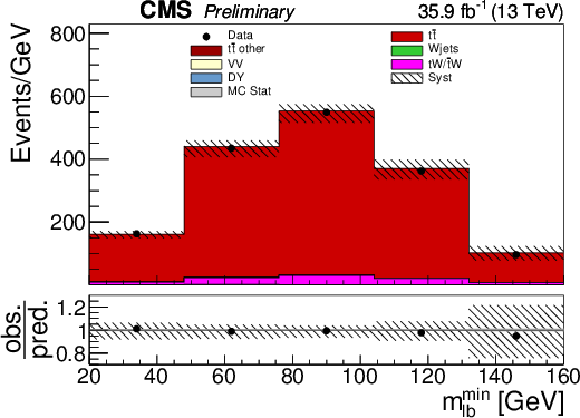
png pdf |
Figure 8-e:
Pre-fit distributions for the simultaneous fit of ${\sigma _{\mathrm {t}\overline {\mathrm {t}}}}$ and ${m_\mathrm {t}^{\mathrm {MC}}}$. Categories in the same column have the same number of b-tagged jets (from left to right: zero or more than two, one, and two b-tagged jets) while categories in the same row have the same number of additional jets (uppermost to lowermost: zero additional jets, one additional jet, two additional jets, three or more additional jets). The hatched bands correspond to the total uncertainty in the sum of the predicted yields. The ratios of data to the sum of the predicted yields are shown in the lower panel of each figure. Here, the solid grey band represents the contribution of the statistical uncertainty. |

png pdf |
Figure 8-f:
Pre-fit distributions for the simultaneous fit of ${\sigma _{\mathrm {t}\overline {\mathrm {t}}}}$ and ${m_\mathrm {t}^{\mathrm {MC}}}$. Categories in the same column have the same number of b-tagged jets (from left to right: zero or more than two, one, and two b-tagged jets) while categories in the same row have the same number of additional jets (uppermost to lowermost: zero additional jets, one additional jet, two additional jets, three or more additional jets). The hatched bands correspond to the total uncertainty in the sum of the predicted yields. The ratios of data to the sum of the predicted yields are shown in the lower panel of each figure. Here, the solid grey band represents the contribution of the statistical uncertainty. |

png pdf |
Figure 8-g:
Pre-fit distributions for the simultaneous fit of ${\sigma _{\mathrm {t}\overline {\mathrm {t}}}}$ and ${m_\mathrm {t}^{\mathrm {MC}}}$. Categories in the same column have the same number of b-tagged jets (from left to right: zero or more than two, one, and two b-tagged jets) while categories in the same row have the same number of additional jets (uppermost to lowermost: zero additional jets, one additional jet, two additional jets, three or more additional jets). The hatched bands correspond to the total uncertainty in the sum of the predicted yields. The ratios of data to the sum of the predicted yields are shown in the lower panel of each figure. Here, the solid grey band represents the contribution of the statistical uncertainty. |

png pdf |
Figure 8-h:
Pre-fit distributions for the simultaneous fit of ${\sigma _{\mathrm {t}\overline {\mathrm {t}}}}$ and ${m_\mathrm {t}^{\mathrm {MC}}}$. Categories in the same column have the same number of b-tagged jets (from left to right: zero or more than two, one, and two b-tagged jets) while categories in the same row have the same number of additional jets (uppermost to lowermost: zero additional jets, one additional jet, two additional jets, three or more additional jets). The hatched bands correspond to the total uncertainty in the sum of the predicted yields. The ratios of data to the sum of the predicted yields are shown in the lower panel of each figure. Here, the solid grey band represents the contribution of the statistical uncertainty. |
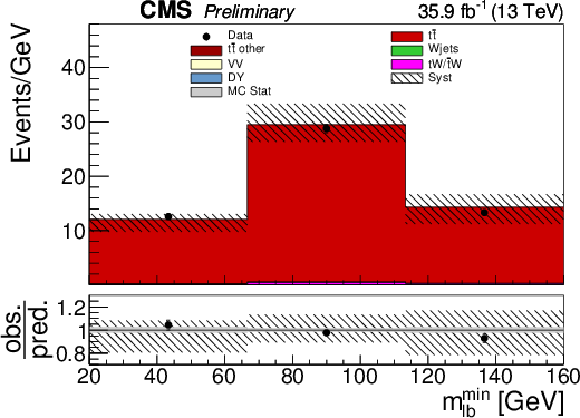
png pdf |
Figure 8-i:
Pre-fit distributions for the simultaneous fit of ${\sigma _{\mathrm {t}\overline {\mathrm {t}}}}$ and ${m_\mathrm {t}^{\mathrm {MC}}}$. Categories in the same column have the same number of b-tagged jets (from left to right: zero or more than two, one, and two b-tagged jets) while categories in the same row have the same number of additional jets (uppermost to lowermost: zero additional jets, one additional jet, two additional jets, three or more additional jets). The hatched bands correspond to the total uncertainty in the sum of the predicted yields. The ratios of data to the sum of the predicted yields are shown in the lower panel of each figure. Here, the solid grey band represents the contribution of the statistical uncertainty. |

png pdf |
Figure 8-j:
Pre-fit distributions for the simultaneous fit of ${\sigma _{\mathrm {t}\overline {\mathrm {t}}}}$ and ${m_\mathrm {t}^{\mathrm {MC}}}$. Categories in the same column have the same number of b-tagged jets (from left to right: zero or more than two, one, and two b-tagged jets) while categories in the same row have the same number of additional jets (uppermost to lowermost: zero additional jets, one additional jet, two additional jets, three or more additional jets). The hatched bands correspond to the total uncertainty in the sum of the predicted yields. The ratios of data to the sum of the predicted yields are shown in the lower panel of each figure. Here, the solid grey band represents the contribution of the statistical uncertainty. |
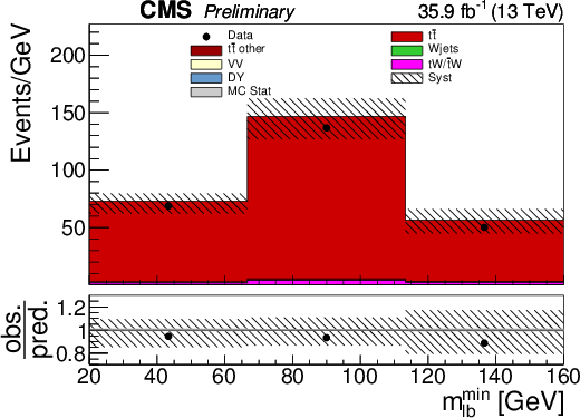
png pdf |
Figure 8-k:
Pre-fit distributions for the simultaneous fit of ${\sigma _{\mathrm {t}\overline {\mathrm {t}}}}$ and ${m_\mathrm {t}^{\mathrm {MC}}}$. Categories in the same column have the same number of b-tagged jets (from left to right: zero or more than two, one, and two b-tagged jets) while categories in the same row have the same number of additional jets (uppermost to lowermost: zero additional jets, one additional jet, two additional jets, three or more additional jets). The hatched bands correspond to the total uncertainty in the sum of the predicted yields. The ratios of data to the sum of the predicted yields are shown in the lower panel of each figure. Here, the solid grey band represents the contribution of the statistical uncertainty. |

png pdf |
Figure 8-l:
Pre-fit distributions for the simultaneous fit of ${\sigma _{\mathrm {t}\overline {\mathrm {t}}}}$ and ${m_\mathrm {t}^{\mathrm {MC}}}$. Categories in the same column have the same number of b-tagged jets (from left to right: zero or more than two, one, and two b-tagged jets) while categories in the same row have the same number of additional jets (uppermost to lowermost: zero additional jets, one additional jet, two additional jets, three or more additional jets). The hatched bands correspond to the total uncertainty in the sum of the predicted yields. The ratios of data to the sum of the predicted yields are shown in the lower panel of each figure. Here, the solid grey band represents the contribution of the statistical uncertainty. |

png pdf |
Figure 9:
Post-fit distributions for the simultaneous fit of ${\sigma _{\mathrm {t}\overline {\mathrm {t}}}}$ and ${m_\mathrm {t}^{\mathrm {MC}}}$. Categories in the same column have the same number of b-tagged jets (from left to right: zero or more than two, one, and two b-tagged jets) while categories in the same row have the same number of additional jets (uppermost to lowermost: zero additional jets, one additional jet, two additional jets, three or more additional jets). The hatched bands correspond to the total uncertainty in the sum of the predicted yields and include the contribution from the top quark mass ($\Delta {m_\mathrm {t}^{\mathrm {MC}}} $). The ratios of data to the sum of the predicted yields are shown in the lower panel of each figure. Here, the solid grey band represents the contribution of the statistical uncertainty. |
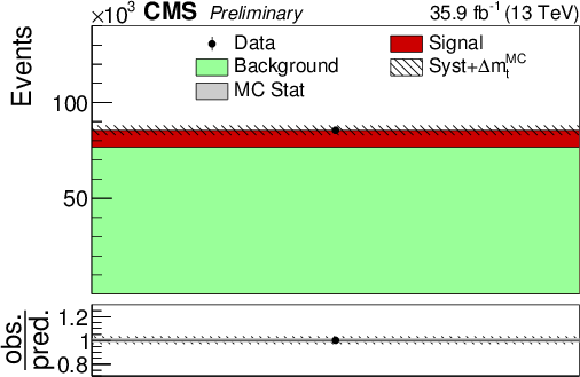
png pdf |
Figure 9-a:
Post-fit distributions for the simultaneous fit of ${\sigma _{\mathrm {t}\overline {\mathrm {t}}}}$ and ${m_\mathrm {t}^{\mathrm {MC}}}$. Categories in the same column have the same number of b-tagged jets (from left to right: zero or more than two, one, and two b-tagged jets) while categories in the same row have the same number of additional jets (uppermost to lowermost: zero additional jets, one additional jet, two additional jets, three or more additional jets). The hatched bands correspond to the total uncertainty in the sum of the predicted yields and include the contribution from the top quark mass ($\Delta {m_\mathrm {t}^{\mathrm {MC}}} $). The ratios of data to the sum of the predicted yields are shown in the lower panel of each figure. Here, the solid grey band represents the contribution of the statistical uncertainty. |

png pdf |
Figure 9-b:
Post-fit distributions for the simultaneous fit of ${\sigma _{\mathrm {t}\overline {\mathrm {t}}}}$ and ${m_\mathrm {t}^{\mathrm {MC}}}$. Categories in the same column have the same number of b-tagged jets (from left to right: zero or more than two, one, and two b-tagged jets) while categories in the same row have the same number of additional jets (uppermost to lowermost: zero additional jets, one additional jet, two additional jets, three or more additional jets). The hatched bands correspond to the total uncertainty in the sum of the predicted yields and include the contribution from the top quark mass ($\Delta {m_\mathrm {t}^{\mathrm {MC}}} $). The ratios of data to the sum of the predicted yields are shown in the lower panel of each figure. Here, the solid grey band represents the contribution of the statistical uncertainty. |
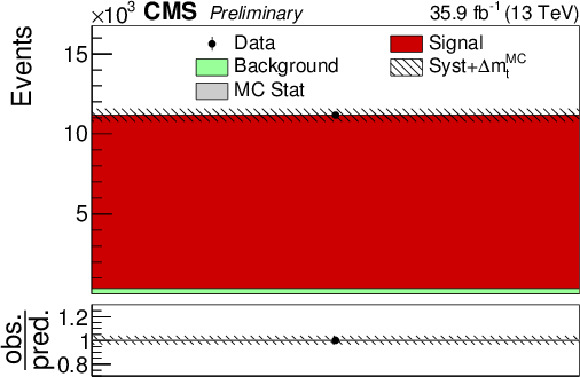
png pdf |
Figure 9-c:
Post-fit distributions for the simultaneous fit of ${\sigma _{\mathrm {t}\overline {\mathrm {t}}}}$ and ${m_\mathrm {t}^{\mathrm {MC}}}$. Categories in the same column have the same number of b-tagged jets (from left to right: zero or more than two, one, and two b-tagged jets) while categories in the same row have the same number of additional jets (uppermost to lowermost: zero additional jets, one additional jet, two additional jets, three or more additional jets). The hatched bands correspond to the total uncertainty in the sum of the predicted yields and include the contribution from the top quark mass ($\Delta {m_\mathrm {t}^{\mathrm {MC}}} $). The ratios of data to the sum of the predicted yields are shown in the lower panel of each figure. Here, the solid grey band represents the contribution of the statistical uncertainty. |
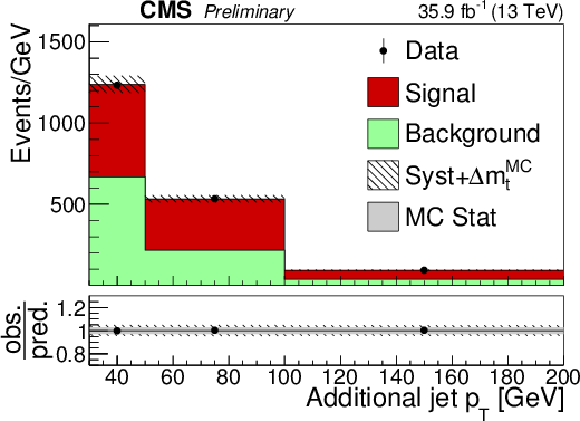
png pdf |
Figure 9-d:
Post-fit distributions for the simultaneous fit of ${\sigma _{\mathrm {t}\overline {\mathrm {t}}}}$ and ${m_\mathrm {t}^{\mathrm {MC}}}$. Categories in the same column have the same number of b-tagged jets (from left to right: zero or more than two, one, and two b-tagged jets) while categories in the same row have the same number of additional jets (uppermost to lowermost: zero additional jets, one additional jet, two additional jets, three or more additional jets). The hatched bands correspond to the total uncertainty in the sum of the predicted yields and include the contribution from the top quark mass ($\Delta {m_\mathrm {t}^{\mathrm {MC}}} $). The ratios of data to the sum of the predicted yields are shown in the lower panel of each figure. Here, the solid grey band represents the contribution of the statistical uncertainty. |

png pdf |
Figure 9-e:
Post-fit distributions for the simultaneous fit of ${\sigma _{\mathrm {t}\overline {\mathrm {t}}}}$ and ${m_\mathrm {t}^{\mathrm {MC}}}$. Categories in the same column have the same number of b-tagged jets (from left to right: zero or more than two, one, and two b-tagged jets) while categories in the same row have the same number of additional jets (uppermost to lowermost: zero additional jets, one additional jet, two additional jets, three or more additional jets). The hatched bands correspond to the total uncertainty in the sum of the predicted yields and include the contribution from the top quark mass ($\Delta {m_\mathrm {t}^{\mathrm {MC}}} $). The ratios of data to the sum of the predicted yields are shown in the lower panel of each figure. Here, the solid grey band represents the contribution of the statistical uncertainty. |

png pdf |
Figure 9-f:
Post-fit distributions for the simultaneous fit of ${\sigma _{\mathrm {t}\overline {\mathrm {t}}}}$ and ${m_\mathrm {t}^{\mathrm {MC}}}$. Categories in the same column have the same number of b-tagged jets (from left to right: zero or more than two, one, and two b-tagged jets) while categories in the same row have the same number of additional jets (uppermost to lowermost: zero additional jets, one additional jet, two additional jets, three or more additional jets). The hatched bands correspond to the total uncertainty in the sum of the predicted yields and include the contribution from the top quark mass ($\Delta {m_\mathrm {t}^{\mathrm {MC}}} $). The ratios of data to the sum of the predicted yields are shown in the lower panel of each figure. Here, the solid grey band represents the contribution of the statistical uncertainty. |
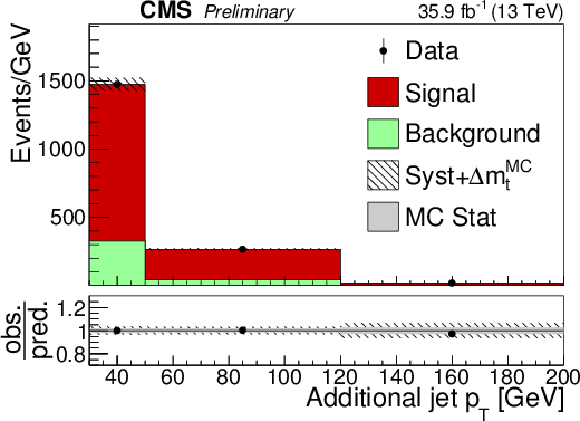
png pdf |
Figure 9-g:
Post-fit distributions for the simultaneous fit of ${\sigma _{\mathrm {t}\overline {\mathrm {t}}}}$ and ${m_\mathrm {t}^{\mathrm {MC}}}$. Categories in the same column have the same number of b-tagged jets (from left to right: zero or more than two, one, and two b-tagged jets) while categories in the same row have the same number of additional jets (uppermost to lowermost: zero additional jets, one additional jet, two additional jets, three or more additional jets). The hatched bands correspond to the total uncertainty in the sum of the predicted yields and include the contribution from the top quark mass ($\Delta {m_\mathrm {t}^{\mathrm {MC}}} $). The ratios of data to the sum of the predicted yields are shown in the lower panel of each figure. Here, the solid grey band represents the contribution of the statistical uncertainty. |
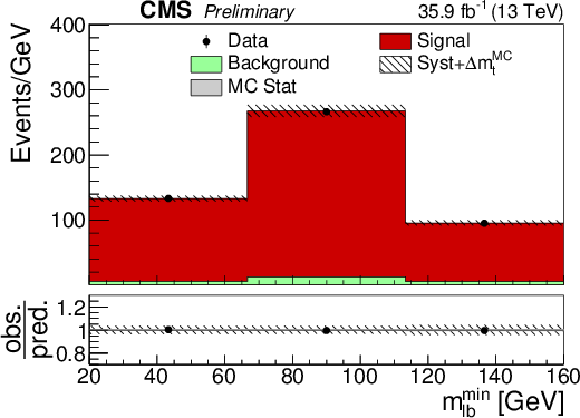
png pdf |
Figure 9-h:
Post-fit distributions for the simultaneous fit of ${\sigma _{\mathrm {t}\overline {\mathrm {t}}}}$ and ${m_\mathrm {t}^{\mathrm {MC}}}$. Categories in the same column have the same number of b-tagged jets (from left to right: zero or more than two, one, and two b-tagged jets) while categories in the same row have the same number of additional jets (uppermost to lowermost: zero additional jets, one additional jet, two additional jets, three or more additional jets). The hatched bands correspond to the total uncertainty in the sum of the predicted yields and include the contribution from the top quark mass ($\Delta {m_\mathrm {t}^{\mathrm {MC}}} $). The ratios of data to the sum of the predicted yields are shown in the lower panel of each figure. Here, the solid grey band represents the contribution of the statistical uncertainty. |

png pdf |
Figure 9-i:
Post-fit distributions for the simultaneous fit of ${\sigma _{\mathrm {t}\overline {\mathrm {t}}}}$ and ${m_\mathrm {t}^{\mathrm {MC}}}$. Categories in the same column have the same number of b-tagged jets (from left to right: zero or more than two, one, and two b-tagged jets) while categories in the same row have the same number of additional jets (uppermost to lowermost: zero additional jets, one additional jet, two additional jets, three or more additional jets). The hatched bands correspond to the total uncertainty in the sum of the predicted yields and include the contribution from the top quark mass ($\Delta {m_\mathrm {t}^{\mathrm {MC}}} $). The ratios of data to the sum of the predicted yields are shown in the lower panel of each figure. Here, the solid grey band represents the contribution of the statistical uncertainty. |

png pdf |
Figure 9-j:
Post-fit distributions for the simultaneous fit of ${\sigma _{\mathrm {t}\overline {\mathrm {t}}}}$ and ${m_\mathrm {t}^{\mathrm {MC}}}$. Categories in the same column have the same number of b-tagged jets (from left to right: zero or more than two, one, and two b-tagged jets) while categories in the same row have the same number of additional jets (uppermost to lowermost: zero additional jets, one additional jet, two additional jets, three or more additional jets). The hatched bands correspond to the total uncertainty in the sum of the predicted yields and include the contribution from the top quark mass ($\Delta {m_\mathrm {t}^{\mathrm {MC}}} $). The ratios of data to the sum of the predicted yields are shown in the lower panel of each figure. Here, the solid grey band represents the contribution of the statistical uncertainty. |

png pdf |
Figure 9-k:
Post-fit distributions for the simultaneous fit of ${\sigma _{\mathrm {t}\overline {\mathrm {t}}}}$ and ${m_\mathrm {t}^{\mathrm {MC}}}$. Categories in the same column have the same number of b-tagged jets (from left to right: zero or more than two, one, and two b-tagged jets) while categories in the same row have the same number of additional jets (uppermost to lowermost: zero additional jets, one additional jet, two additional jets, three or more additional jets). The hatched bands correspond to the total uncertainty in the sum of the predicted yields and include the contribution from the top quark mass ($\Delta {m_\mathrm {t}^{\mathrm {MC}}} $). The ratios of data to the sum of the predicted yields are shown in the lower panel of each figure. Here, the solid grey band represents the contribution of the statistical uncertainty. |
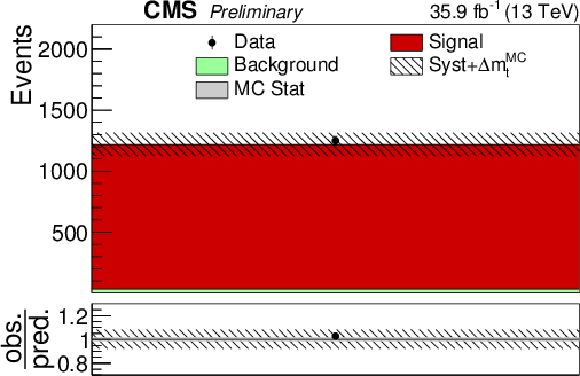
png pdf |
Figure 9-l:
Post-fit distributions for the simultaneous fit of ${\sigma _{\mathrm {t}\overline {\mathrm {t}}}}$ and ${m_\mathrm {t}^{\mathrm {MC}}}$. Categories in the same column have the same number of b-tagged jets (from left to right: zero or more than two, one, and two b-tagged jets) while categories in the same row have the same number of additional jets (uppermost to lowermost: zero additional jets, one additional jet, two additional jets, three or more additional jets). The hatched bands correspond to the total uncertainty in the sum of the predicted yields and include the contribution from the top quark mass ($\Delta {m_\mathrm {t}^{\mathrm {MC}}} $). The ratios of data to the sum of the predicted yields are shown in the lower panel of each figure. Here, the solid grey band represents the contribution of the statistical uncertainty. |
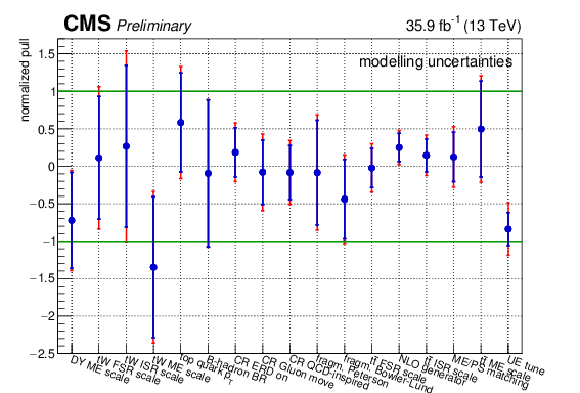
png pdf |
Figure 10:
Pulls and constraints of the nuisance parameters related to modelling uncertainties for the simultaneous fit of ${\sigma _{\mathrm {t}\overline {\mathrm {t}}}}$ and ${m_\mathrm {t}^{\mathrm {MC}}}$. The marker denotes the fitted value, while the inner error band represents the constraint and the outer error band denotes the additional uncertainty from the toy experiments. The horizontal bars represent the pre-fit uncertainty. |

png pdf |
Figure 11:
Left: the values of $\chi ^2({\alpha _\mathrm {S}})$ obtained from comparison of the ${\sigma _{\mathrm {t}\overline {\mathrm {t}}}}$ measurement at $\sqrt {s}=$ 13 TeV to the NNLO prediction in the ${\mathrm {\overline {MS}}}$ scheme using different PDFs (symbols of different styles). Right: the values for ${\alpha _\mathrm {S}(m_\mathrm {Z})}$ for different PDF sets obtained in the ${\mathrm {\overline {MS}}}$ scheme for treatment of the top quark mass in the theory prediction. The uncertainties account for the experimental, the PDF, and the scale variation uncertainties. The values are compared to the world-average value [29], shown by the vertical line and hatched band. |

png pdf |
Figure 11-a:
Left: the values of $\chi ^2({\alpha _\mathrm {S}})$ obtained from comparison of the ${\sigma _{\mathrm {t}\overline {\mathrm {t}}}}$ measurement at $\sqrt {s}=$ 13 TeV to the NNLO prediction in the ${\mathrm {\overline {MS}}}$ scheme using different PDFs (symbols of different styles). Right: the values for ${\alpha _\mathrm {S}(m_\mathrm {Z})}$ for different PDF sets obtained in the ${\mathrm {\overline {MS}}}$ scheme for treatment of the top quark mass in the theory prediction. The uncertainties account for the experimental, the PDF, and the scale variation uncertainties. The values are compared to the world-average value [29], shown by the vertical line and hatched band. |

png pdf |
Figure 11-b:
Left: the values of $\chi ^2({\alpha _\mathrm {S}})$ obtained from comparison of the ${\sigma _{\mathrm {t}\overline {\mathrm {t}}}}$ measurement at $\sqrt {s}=$ 13 TeV to the NNLO prediction in the ${\mathrm {\overline {MS}}}$ scheme using different PDFs (symbols of different styles). Right: the values for ${\alpha _\mathrm {S}(m_\mathrm {Z})}$ for different PDF sets obtained in the ${\mathrm {\overline {MS}}}$ scheme for treatment of the top quark mass in the theory prediction. The uncertainties account for the experimental, the PDF, and the scale variation uncertainties. The values are compared to the world-average value [29], shown by the vertical line and hatched band. |

png pdf |
Figure 12:
Summary of the results for ${m_\mathrm {t}(m_\mathrm {t})}$ (left) and of ${m_\mathrm {t}^{\mathrm {pole}}}$ (right) using different PDF sets. The inner part of the horisontal error bar represents the combination of experimental, PDF, and $\alpha _\mathrm {S}$ uncertainties, while the outer error bar represents the total uncertainty. |

png pdf |
Figure 12-a:
Summary of the results for ${m_\mathrm {t}(m_\mathrm {t})}$ (left) and of ${m_\mathrm {t}^{\mathrm {pole}}}$ (right) using different PDF sets. The inner part of the horisontal error bar represents the combination of experimental, PDF, and $\alpha _\mathrm {S}$ uncertainties, while the outer error bar represents the total uncertainty. |

png pdf |
Figure 12-b:
Summary of the results for ${m_\mathrm {t}(m_\mathrm {t})}$ (left) and of ${m_\mathrm {t}^{\mathrm {pole}}}$ (right) using different PDF sets. The inner part of the horisontal error bar represents the combination of experimental, PDF, and $\alpha _\mathrm {S}$ uncertainties, while the outer error bar represents the total uncertainty. |
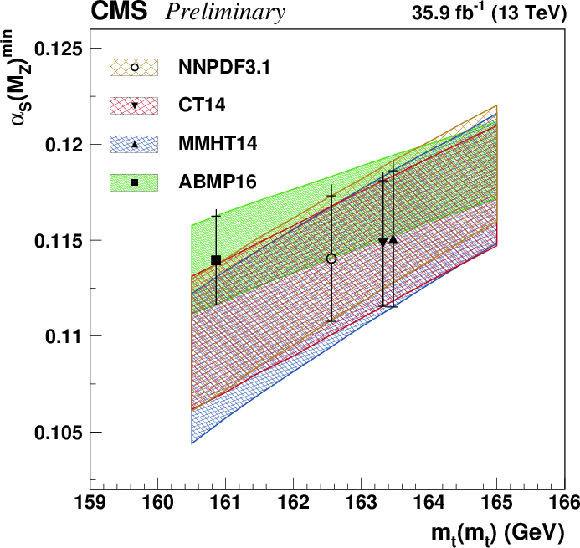
png pdf |
Figure 13:
The values of ${\alpha _\mathrm {S}(m_\mathrm {Z})}$ obtained in comparison of the ${\sigma _{\mathrm {t}\overline {\mathrm {t}}}}$ measurement at $\sqrt {s}=$ 13 TeV to the NNLO prediction using different PDFs shown as a function of ${m_\mathrm {t}(m_\mathrm {t})}$ used in the NNLO calculation. Different PDFs used are represented by the bands of different shades, with the band width corresponding to the experimental and PDF uncertainties. The extracted values of ${\alpha _\mathrm {S}(m_\mathrm {Z})}$ for each PDF are shown by the markers of different style, shown at the ${m_\mathrm {t}(m_\mathrm {t})}$ values used for each PDF. |
| Tables | |
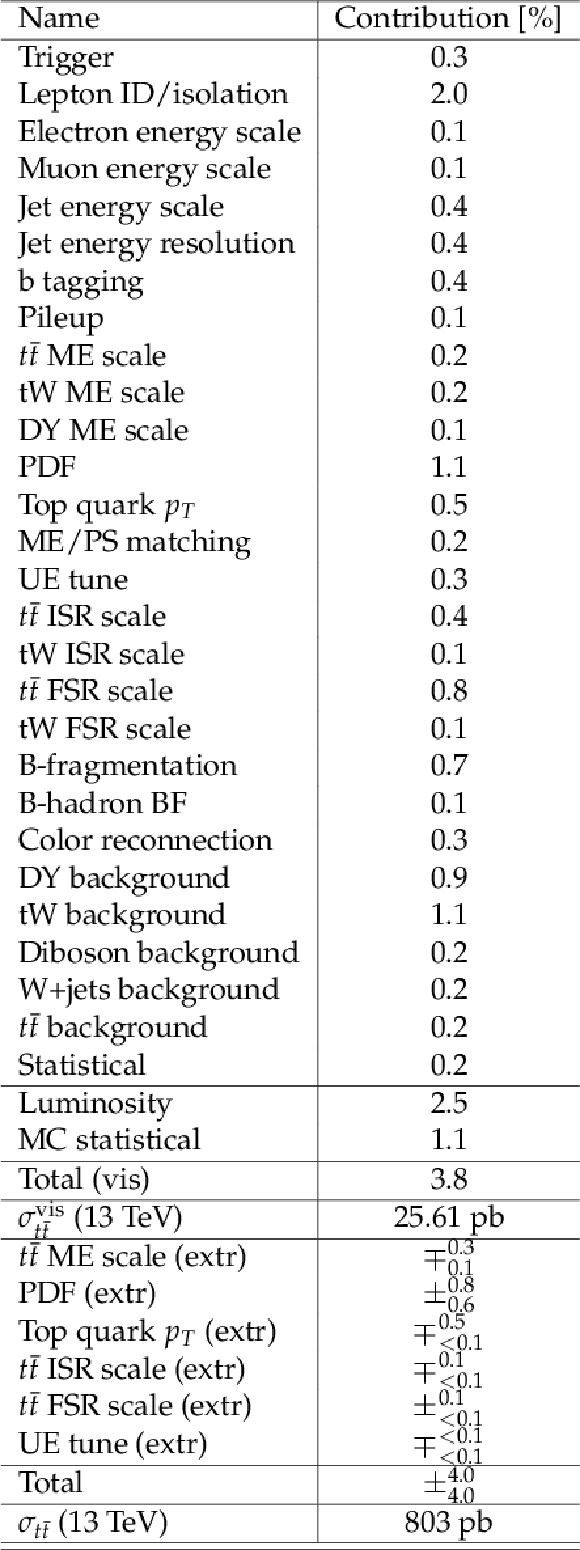
png pdf |
Table 1:
The measured visible and total ${{\mathrm {t}\overline {\mathrm {t}}}}$ cross sections and a breakdown of their systematic and statistical uncertainties as obtained from the template fit. The individual uncertainties are given without their correlation, but it is accounted for in the total uncertainties. |

png pdf |
Table 2:
Results of the simultaneous fit of ${\sigma _{\mathrm {t}\overline {\mathrm {t}}}}$ (left) and ${m_\mathrm {t}^{\mathrm {MC}}}$ (right). The errors from the luminosity uncertainty and the statistics of the simulated samples are determined separately from the fit. In this case, definition of $ {\sigma _{{{\mathrm {t}\overline {\mathrm {t}}}}}^{\mathrm {vis}}} $ is restricted to the $\mathrm {e^{\mp}}\mu ^{\pm}$ channel. |

png pdf |
Table 3:
The values of the top quark pole mass used in the different PDF sets and the corresponding values of ${m_\mathrm {t}(m_\mathrm {t})}$ obtained using the RunDec [77,78] conversion. |

png pdf |
Table 4:
Values of ${\alpha _\mathrm {S}(m_\mathrm {Z})}$ with their uncertainties obtained using different PDF sets. The ${\mathrm {\overline {MS}}}$ scheme is used for the top quark mass treatment in the theory prediction. |

png pdf |
Table 5:
Values of ${\alpha _\mathrm {S}(m_\mathrm {Z})}$ with their uncertainties obtained using different PDF sets. The pole mass scheme is used for the top quark mass treatment in the theory prediction. |

png pdf |
Table 6:
Extraction of ${m_\mathrm {t}(m_\mathrm {t})}$ at NNLO from ${\sigma _{\mathrm {t}\overline {\mathrm {t}}}}$ using different PDF sets. |

png pdf |
Table 7:
Extraction of ${m_\mathrm {t}^{\mathrm {pole}}}$ at NNLO from ${\sigma _{\mathrm {t}\overline {\mathrm {t}}}}$ using different PDF sets. |
| Summary |
|
A precise measurement of the $\mathrm{t\bar{t}}$ production cross section in proton-proton collisions at a centre-of-mass energy of 13 TeV is presented. Assuming a top quark mass ${m_\mathrm{t}}^{\text{MC}}$ of 172.5 GeV, the visible cross section ${\sigma_{\mathrm{t\bar{t}}}^{\mathrm{vis}}}$ for $\mathrm{t\bar{t}}$ production with two final-state leptons of transverse momenta larger than 25 and 20 GeV and pseudorapidity $ | \eta | < $ 2.4, is measured to be ${\sigma_{\mathrm{t\bar{t}}}^{\mathrm{vis}}} = $ 25.61 $\pm$ 0.05 (stat) $\pm$ 0.75 (syst) $\pm$ 0.64 (lum) pb. By extrapolating to the full phase space, the total $\mathrm{t\bar{t}}$ production cross section is found to be ${\sigma_\mathrm{t\bar{t}}} = $ 803 $\pm$ 2 (stat) $\pm$ 25 (syst) $\pm$ 20 (lum) pb. The total uncertainty is 33 pb (4.0%). The measurement is in good agreement with the theoretical prediction calculated to next-to-next-to-leading order in perturbative QCD, including soft-gluon resummation to next-to-next-to-leading logarithms. The measurement is repeated including the top quark mass as an additional free parameter of interest in a simultaneous fit of ${\sigma_\mathrm{t\bar{t}}} $ and ${m_\mathrm{t}}^{\text{MC}}$. The fit yields a top quark mass value ${m_\mathrm{t}}^{\text{MC}} = $ 172.33 $\pm$ 0.14 (stat) $^{+0.66}_{-0.72}$ (syst) GeV, in good agreement with previous measurements. The value of ${\sigma_\mathrm{t\bar{t}}} $ obtained in the simultaneous fit is further used to extract the values of the top quark mass and of the strong coupling at NNLO, using both the ${\mathrm{\overline{MS}}}$ and pole mass renormalization schemes for different PDFs. |
| References | ||||
| 1 | CMS Collaboration | Measurement of the inclusive $ \mathrm{t}\overline{\mathrm{t}} $ cross section in pp collisions at $ \sqrt{s}= $ 5.02 TeV using final states with at least one charged lepton | JHEP 03 (2018) 115 | CMS-TOP-16-023 1711.03143 |
| 2 | CMS Collaboration | Measurement of the $ \mathrm{t} \bar{\mathrm{t}} $ production cross section in the e-$ \mu $ channel in proton-proton collisions at $ \sqrt{s}= $ 7 and 8 TeV | JHEP 08 (2016) 029 | CMS-TOP-13-004 1603.02303 |
| 3 | CMS Collaboration | Measurement of the $ \mathrm{t} \bar{\mathrm{t}} $ production cross section using events with one lepton and at least one jet in pp collisions at $ \sqrt{s} = $ 13 TeV | JHEP 09 (2017) 051 | CMS-TOP-16-006 1701.06228 |
| 4 | ATLAS Collaboration | Measurement of the $ \mathrm{t} \bar{\mathrm{t}} $ production cross-section using $ e\mu $ events with b-tagged jets in pp collisions at $ \sqrt{s} = $ 7 and 8 $ \mathrm{TeV} $ with the ATLAS detector | Eur.\,Phys.\,J.\,C 74 (2014) 3109 | 1406.5375 |
| 5 | ATLAS Collaboration | Measurement of the $ \mathrm{t} \bar{\mathrm{t}} $ production cross-section using $ e\mu $ events with b-tagged jets in pp collisions at $ \sqrt{s} = $ 13 TeV with the ATLAS detector | Phys.\,Lett.\,B 761 (2016) 136 | 1606.02699 |
| 6 | P. Barnreuther, M. Czakon, and A. Mitov | Percent-level-precision physics at the Tevatron: next-to-next-to-leading order QCD corrections to $ q\overline{q} {\rightarrow}t\overline{t}\mathbf{+}X $ | Phys.\,Rev.\,Lett. 109 (2012) 132001 | |
| 7 | M. Czakon and A. Mitov | NNLO corrections to top-pair production at hadron colliders: the all-fermionic scattering channels | JHEP 12 (2012) 054 | 1207.0236 |
| 8 | M. Czakon and A. Mitov | NNLO corrections to top pair production at hadron colliders: the quark-gluon reaction | JHEP 01 (2013) 080 | 1210.6832 |
| 9 | M. Czakon, P. Fiedler, and A. Mitov | Total top-quark pair-production cross section at hadron colliders through $ O({\alpha_S}^4) $ | Phys.\,Rev.\,Lett.\, 110 (2013) 252004 | 1303.6254 |
| 10 | D0 Collaboration | Determination of the pole and $ \overline{\mathrm{MS}} $ masses of the top quark from the $ \mathrm{t} \bar{\mathrm{t}} $ cross section | Phys.\,Lett.\,B 703 (2011) 422 | 1104.2887 |
| 11 | CMS Collaboration | Determination of the top-quark pole mass and strong coupling constant from the $ \mathrm{t} \bar{\mathrm{t}} $ production cross section in pp collisions at $ \sqrt{s} = $ 7 TeV | Phys.\,Lett.\,B 728 (2014) 496 | CMS-TOP-12-022 1307.1907 |
| 12 | D0 Collaboration | Measurement of the inclusive $ \mathrm{t} \bar{\mathrm{t}} $ production cross section in $ \mathrm{p} \bar{\mathrm{p}} $ collisions at $ \sqrt{s}= $ 1.96 TeV and determination of the top quark pole mass | Phys.\,Rev.\,D 94 (2016) 092004 | 1605.06168 |
| 13 | T. Klijnsma, S. Bethke, G. Dissertori, and G. P. Salam | Determination of the strong coupling constant $ \alpha_s(m_Z) $ from measurements of the total cross section for top-antitop quark production | EPJC 77 (2017) 778 | 1708.07495 |
| 14 | M. Czakon, M. L. Mangano, A. Mitov, and J. Rojo | Constraints on the gluon PDF from top quark pair production at hadron colliders | JHEP 07 (2013) 167 | 1303.7215 |
| 15 | M. Guzzi, K. Lipka, and S.-O. Moch | Top-quark pair production at hadron colliders: differential cross section and phenomenological applications with DiffTop | JHEP 01 (2015) 082 | 1406.0386 |
| 16 | CMS Collaboration | Measurement of double-differential cross sections for top quark pair production in pp collisions at $ \sqrt{s} = $ 8 TeV and impact on parton distribution functions | Eur.\,Phys.\,J.\,C 77 (2017) 459 | CMS-TOP-14-013 1703.01630 |
| 17 | S. Alekhin, J. Blumlein, S. Moch, and R. Placakyte | Parton distribution functions, $ \alpha_s $, and heavy-quark masses for LHC Run II | Phys.\,Rev.\,D 96 (2017) 014011 | 1701.05838 |
| 18 | Gfitter Group Collaboration | The global electroweak fit at NNLO and prospects for the LHC and ILC | Eur.\,Phys.\,J.\,C 74 (2014) 3046 | 1407.3792 |
| 19 | G. Degrassi et al. | Higgs mass and vacuum stability in the Standard Model at NNLO | JHEP 08 (2012) 098 | 1205.6497 |
| 20 | M. Dowling and S.-O. Moch | Differential distributions for top-quark hadro-production with a running mass | Eur.\,Phys.\,J.\,C 74 (2014) 3167 | 1305.6422 |
| 21 | P. Marquard, A. V. Smirnov, V. A. Smirnov, and M. Steinhauser | Quark mass relations to four-loop order in perturbative QCD | Phys.\,Rev.\,Lett. 114 (2015) 142002 | 1502.01030 |
| 22 | CDF and D0 Collaboration | Combination of CDF and D0 results on the mass of the top quark using up $ 9.7\:{\rm fb}^{-1} $ at the Tevatron | 1608.01881 | |
| 23 | ATLAS Collaboration | Measurement of the top quark mass in the $ \mathrm{t} \bar{\mathrm{t}} \to $ dilepton channel from $ \sqrt{s}= $ 8 TeV ATLAS data | Phys.\,Lett.\,B 761 (2016) 350 | 1606.02179 |
| 24 | CMS Collaboration | Measurement of the top quark mass using proton-proton data at $ {\sqrt{s}} = $ 7 and 8 TeV | Phys.\,Rev.\,D 93 (2016) 072004 | CMS-TOP-14-022 1509.04044 |
| 25 | ATLAS, CDF, CMS, D0 Collaboration | First combination of Tevatron and LHC measurements of the top-quark mass | 1403.4427 | |
| 26 | CMS Collaboration | Measurement of masses in the $ \mathrm{t} \bar{\mathrm{t}} $ system by kinematic endpoints in pp collisions at $ \sqrt{s} = $ 7 TeV | Eur.\,Phys.\,J.\,C 73 (2013) 2494 | CMS-TOP-11-027 1304.5783 |
| 27 | A. Buckley et al. | General-purpose event generators for LHC physics | Phys.\,Rept. 504 (2011) 145 | 1101.2599 |
| 28 | A. H. Hoang, S. Platzer, and D. Samitz | On the cutoff dependence of the quark mass parameter in angular ordered parton showers | 1807.06617 | |
| 29 | Particle Data Group Collaboration | Review of particle physics | Chin.\,Phys.\,C 40 (2016) 100001 | |
| 30 | J. Kieseler, K. Lipka, and S.-O. Moch | Calibration of the top-quark Monte Carlo mass | Phys.\,Rev.\,Lett. 116 (2016) 162001 | 1511.00841 |
| 31 | CMS Collaboration | Measurement of the top quark mass with lepton+jets final states using pp collisions at $ \sqrt{s}= $ 13 TeV | CMS-TOP-17-007 1805.01428 |
|
| 32 | CMS Collaboration | The CMS experiment at the CERN LHC | JINST 3 (2008) S08004 | CMS-00-001 |
| 33 | S. Alioli et al. | A general framework for implementing NLO calculations in shower Monte Carlo programs: the POWHEG BOX | JHEP 06 (2010) 043 | 1002.2581 |
| 34 | S. Frixione, P. Nason, and C. Oleari | Matching NLO QCD computations with Parton Shower simulations: the POWHEG method | JHEP 11 (2007) 070 | 0709.2092 |
| 35 | P. Nason | A New method for combining NLO QCD with shower Monte Carlo algorithms | JHEP 11 (2004) 040 | hep-ph/0409146 |
| 36 | S. Frixione, P. Nason, and G. Ridolfi | A Positive-weight next-to-leading-order Monte Carlo for heavy flavour hadroproduction | JHEP 09 (2007) 126 | 0707.3088 |
| 37 | CMS Collaboration | Investigations of the impact of the parton shower tuning in Pythia 8 in the modelling of $ \mathrm{t\overline{t}} $ at $ \sqrt{s}= $ 8 and 13 TeV | CMS-PAS-TOP-16-021 | CMS-PAS-TOP-16-021 |
| 38 | NNPDF Collaboration | Parton distributions with LHC data | Nucl.\,Phys.\,B 867 (2013) 244 | 1207.1303 |
| 39 | T. Sjostrand et al. | An introduction to PYTHIA 8.2 | Comput.\,Phys.\,Commun. 191 (2015) 159 | 1410.3012 |
| 40 | P. Skands, S. Carrazza, and J. Rojo | Tuning PYTHIA 8.1: the Monash 2013 Tune | Eur.\,Phys.\,J.\,C 74 (2014) 3024 | 1404.5630 |
| 41 | A. Kardos, P. Nason, and C. Oleari | Three-jet production in POWHEG | JHEP 04 (2014) 043 | 1402.4001 |
| 42 | E. Re | Single-top Wt-channel production matched with parton showers using the POWHEG method | EPJC 71 (2011) 1547 | 1009.2450 |
| 43 | S. Alioli, P. Nason, C. Oleari, and E. Re | Vector boson plus one jet production in POWHEG | JHEP 01 (2011) 095 | 1009.5594 |
| 44 | J. Alwall et al. | The automated computation of tree-level and next-to-leading order differential cross sections, and their matching to parton shower simulations | JHEP 07 (2014) 079 | 1405.0301 |
| 45 | R. Frederix and S. Frixione | Merging meets matching in MC@NLO | JHEP 12 (2012) 061 | 1209.6215 |
| 46 | R. Gavin, Y. Li, F. Petriello, and S. Quackenbush | FEWZ 2.0: A code for hadronic Z production at next-to-next-to-leading order | CPC 182 (2011) 2388 | 1011.3540 |
| 47 | N. Kidonakis | Two-loop soft anomalous dimensions for single top quark associated production with $ \mathrm{W^-} $ or $ \mathrm{H^-} $ | Phys.\,Rev.\,D 82 (2010) 054018 | hep-ph/1005.4451 |
| 48 | J. M. Campbell, R. K. Ellis, and C. Williams | Vector boson pair production at the LHC | JHEP 07 (2011) 018 | 1105.0020 |
| 49 | M. Czakon and A. Mitov | Top++: A program for the calculation of the top-pair cross-section at hadron colliders | Comput.\,Phys.\,Commun. 185 (2014) 2930 | 1112.5675 |
| 50 | S. Dulat et al. | New parton distribution functions from a global analysis of quantum chromodynamics | Phys.\,Rev.\,D 93 (2016) 033006 | 1506.07443 |
| 51 | CMS Collaboration | Particle-flow reconstruction and global event description with the CMS detector | JINST 12 (2017) P10003 | CMS-PRF-14-001 1706.04965 |
| 52 | CMS Collaboration | Performance of electron reconstruction and selection with the CMS detector in proton-proton collisions at $ \sqrt{s} = $ 8 TeV | JINST 10 (2015) P06005 | |
| 53 | CMS Collaboration | Performance of CMS muon reconstruction in pp collision events at $ \sqrt{s}= $ 7 TeV | JINST 7 (2012) P10002 | CMS-MUO-10-004 1206.4071 |
| 54 | M. Cacciari, G. P. Salam, and G. Soyez | The anti-$ k_t $ jet clustering algorithm | JHEP 04 (2008) 063 | 0802.1189 |
| 55 | M. Cacciari, G. P. Salam, and G. Soyez | FastJet user manual | Eur.\,Phys.\,J.\,C 72 (2012) 1896 | 1111.6097 |
| 56 | CMS Collaboration | Jet energy scale and resolution in the CMS experiment in pp collisions at 8 TeV | JINST 12 (2017) P02014 | CMS-JME-13-004 1607.03663 |
| 57 | CMS Collaboration | Identification of heavy-flavour jets with the CMS detector in pp collisions at 13 TeV | JINST 13 (2018) P05011 | CMS-BTV-16-002 1712.07158 |
| 58 | F. James and M. Roos | Minuit: a system for function minimization and analysis of the parameter errors and correlations | Comput.\,Phys.\,Commun. 10 (1975) 343 | |
| 59 | CMS Collaboration | Jet algorithms performance in 13 TeV data | CMS-PAS-JME-16-003 | CMS-PAS-JME-16-003 |
| 60 | ATLAS Collaboration | Measurement of the inelastic proton-proton cross section at $ \sqrt{s} = $ 13 TeV with the ATLAS detector at the LHC | Phys.\,Rev.\,Lett. 117 (2016) 182002 | 1606.02625 |
| 61 | CMS Collaboration | CMS luminosity measurements for the 2016 data taking period | CMS-PAS-LUM-17-001 | CMS-PAS-LUM-17-001 |
| 62 | M. Cacciari et al. | The t anti-t cross-section at 1.8-TeV and 1.96-TeV: A Study of the systematics due to parton densities and scale dependence | JHEP 04 (2004) 068 | hep-ph/0303085 |
| 63 | S. Catani, D. de Florian, M. Grazzini, and P. Nason | Soft gluon resummation for Higgs boson production at hadron colliders | JHEP 07 (2003) 028 | hep-ph/0306211 |
| 64 | CMS Collaboration | Measurement of normalized differential $ \mathrm{t}\overline{\mathrm{t}} $ cross sections in the dilepton channel from pp collisions at $ \sqrt{s}= $ 13 TeV | JHEP 04 (2018) 060 | CMS-TOP-16-007 1708.07638 |
| 65 | CMS Collaboration | Measurement of differential cross sections for top quark pair production using the lepton+jets final state in proton-proton collisions at 13 TeV | Phys.\,Rev.\,D 95 (2017) 092001 | CMS-TOP-16-008 1610.04191 |
| 66 | M. G. Bowler | e$ ^+ $ e$ ^- $ Production of heavy quarks in the String Model | Z. Phys. C 11 (1981) 169 | |
| 67 | C. Peterson, D. Schlatter, I. Schmitt, and P. M. Zerwas | Scaling violations in inclusive e$ ^+ $ e$ ^- $ annihilation spectra | PRD 27 (1983) 105 | |
| 68 | S. Argyropoulos and T. Sjostrand | Effects of color reconnection on $ \mathrm{t} \bar{\mathrm{t}} $ final states at the LHC | JHEP 11 (2014) 043 | 1407.6653 |
| 69 | J. R. Christiansen and P. Z. Skands | String formation beyond leading colour | JHEP 08 (2015) 003 | 1505.01681 |
| 70 | CMS Collaboration | Measurement of the $ \mathrm{t \bar{t}} $ production cross section using events in the $ \mathrm{e} \mu $ final state in pp collisions at $ \sqrt{s} = $ 13 TeV | EPJC 77 (2017) 172 | |
| 71 | S. Alekhin et al. | HERAFitter | Eur.\,Phys.\,J.\,C 75 (2015) 304 | 1410.4412 |
| 72 | H1 and ZEUS Collaboration | Combination of measurements of inclusive deep inelastic $ {\mathrm{e}^{\pm}\mathrm{p}} $ scattering cross sections and QCD analysis of HERA data | Eur.\,Phys.\,J.\,C 75 (2015) 580 | 1506.06042 |
| 73 | CMS Collaboration | Measurement and QCD analysis of double-differential inclusive jet cross sections in pp collisions at $ \sqrt{s}= $ 8 TeV and cross section ratios to 2.76 and 7 TeV | JHEP 03 (2017) 156 | CMS-SMP-14-001 1609.05331 |
| 74 | M. Aliev et al. | HATHOR: HAdronic Top and Heavy quarks crOss section calculatoR | Comput.\,Phys.\,Commun. 182 (2011) 1034 | 1007.1327 |
| 75 | L. A. Harland-Lang, A. D. Martin, P. Motylinski, and R. S. Thorne | Parton distributions in the LHC era: MMHT 2014 PDFs | Eur.\,Phys.\,J.\,C 75 (2015) 204 | 1412.3989 |
| 76 | NNPDF Collaboration | Parton distributions from high-precision collider data | EPJC 77 (2017) 663 | 1706.00428 |
| 77 | K. G. Chetyrkin, J. H. Kuhn, and M. Steinhauser | RunDec: A Mathematica package for running and decoupling of the strong coupling and quark masses | Comput.\,Phys.\,Commun. 133 (2000) 43 | hep-ph/0004189 |
| 78 | B. Schmidt and M. Steinhauser | CRunDec: a C++ package for running and decoupling of the strong coupling and quark masses | Comput.\,Phys.\,Commun. 183 (2012) 1845 | 1201.6149 |
| 79 | H1 Collaboration | Determination of the strong coupling constant $ \alpha_s(m_Z) $ in next-to-next-to-leading order QCD using H1 jet cross section measurements | EPJC 77 (2017) 791 | 1709.07251 |

|
Compact Muon Solenoid LHC, CERN |

|

|

|

|

|

|